Guyana is a small country in South America with a tropical climate that provides a perfect habitat for a wide variety of birds. With over 800 species, Guyana is a paradise for bird lovers.
From the brightly colored toucans and macaws to the majestic harpy eagles, Guyana’s birds are a colorful and interesting mix of species. In addition to the native species, Guyana is home to a number of birds from other parts of the world which have been introduced to the country.
With its diverse habitats ranging from tropical jungles to coastal wetlands, Guyana offers birders an opportunity to witness a broad diversity of birds.
1. Hoatzin
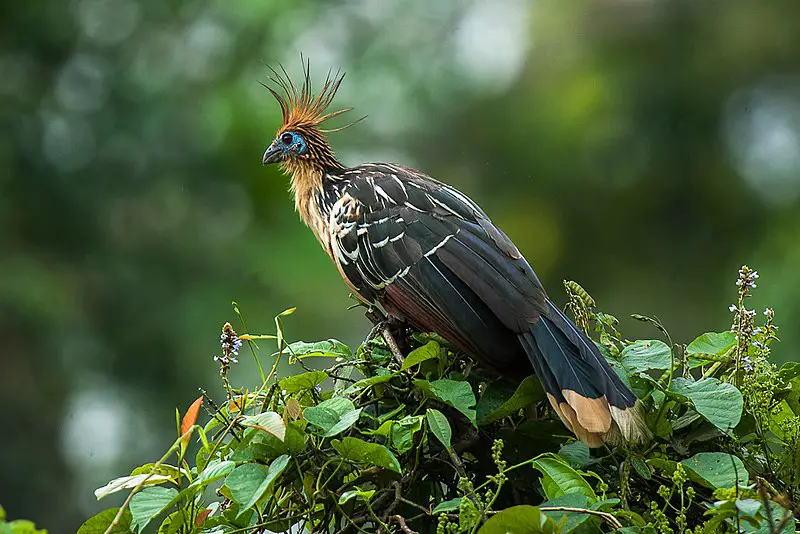
The Hoatzin bird is a tropical species found in the Amazon and Orinoco river basins of South America. It inhabits swamps, riparian forests and mangroves.
This unique bird has chicks that have claws on two of their wing digits which make it the only member in its order – Opisthocomiformes.
Its most distinctive feature is an odour produced from its digestive system which smells like cow manure.
The adults are brownish-grey with blue facial skin, red eyes, pointed crest feathers and black primaries.
They feed mainly on leaves but also eat flowers, fruits or buds when available during different seasons.
They can be heard making loud calls resembling caws at night time as well as repeated whistles throughout the day to keep contact between family members within flocks.Scientific classification:
| Kingdom | Animalia |
| Phylum | Chordata |
| Class | Aves |
| Order | Opisthocomiformes |
| Family | Opisthocomidae |
| Genus | Opisthocomus Illiger, 1811 |
| Species | O. hoazin |
2. Tyrant Flycatchers
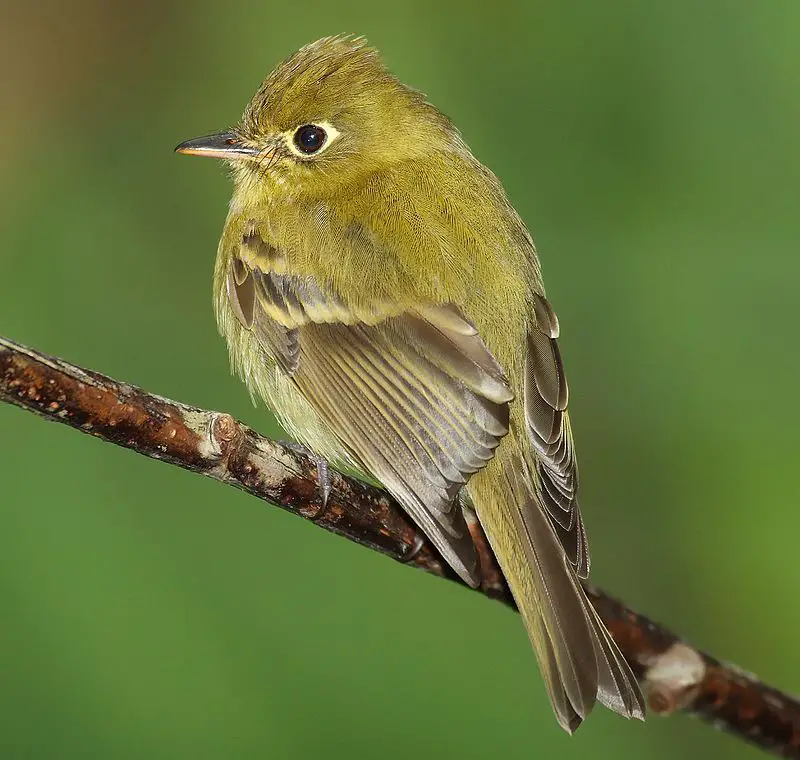
Tyrant flycatchers are a family of birds found in North and South America, containing over 400 species. These birds come in an array of shapes and sizes, with vibrant plumage to match.
They�re the most diverse avian family across all countries they inhabit except for the United States and Canada.
Their diet consists mainly of insects but also includes small reptiles or amphibians where available.
The behavior varies between each bird; some prefer open areas while others like dense forests as their habitat � many even migrate regularly.
Tyrant Flycatchers have adapted well to human presence thanks to the abundance of food sources that often accompany it � such as backyards, parks etc..
All things considered these incredible creatures are truly amazing.Scientific classification:
| Kingdom | Animalia |
| Phylum | Chordata |
| Class | Aves |
| Order | Passeriformes |
| Parvorder | Tyrannida |
| Family | Tyrannidae Vigors, 1825 |
3. Jacanas
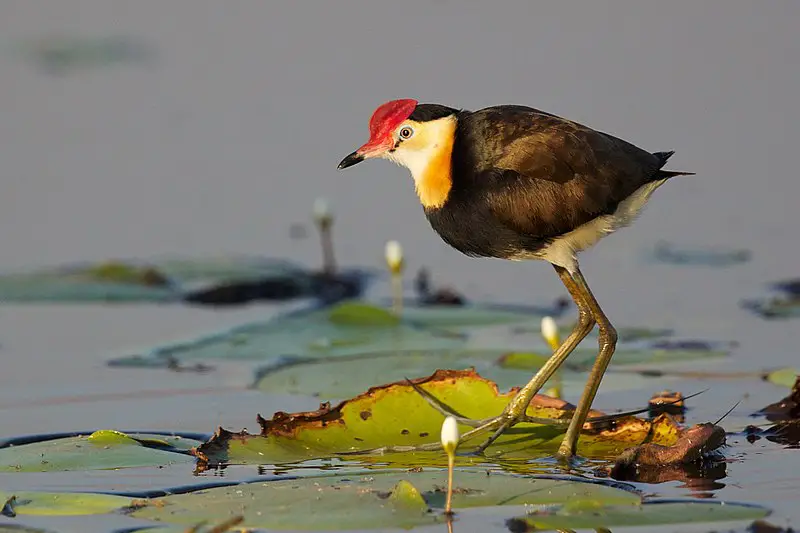
Jacanas are tropical waders belonging to the Jacanidae family. They have distinctive elongated toes and toenails which help them forage on floating or semi-emergent aquatic vegetation.
This adaptation gives them their nickname “Jesus birds” as they seem to be able to walk on water.
The female jacanas are also unique amongst bird species in that they take charge of nest building, incubation and caring for young while males perform courtship displays.
These unusual birds can be found throughout the world’s tropical regions where they inhabit wetlands such as swamps, marshes and shallow lakes with lily pads.
With a wide variety range due their special adaptations these beautiful creatures will surely continue living life at ease around our planet’s warmest waters.Scientific classification:
| Kingdom | Animalia |
| Phylum | Chordata |
| Class | Aves |
| Order | Charadriiformes |
| Suborder | Thinocori |
| Family | Jacanidae Stejneger, 1885 |
4. Tanagers
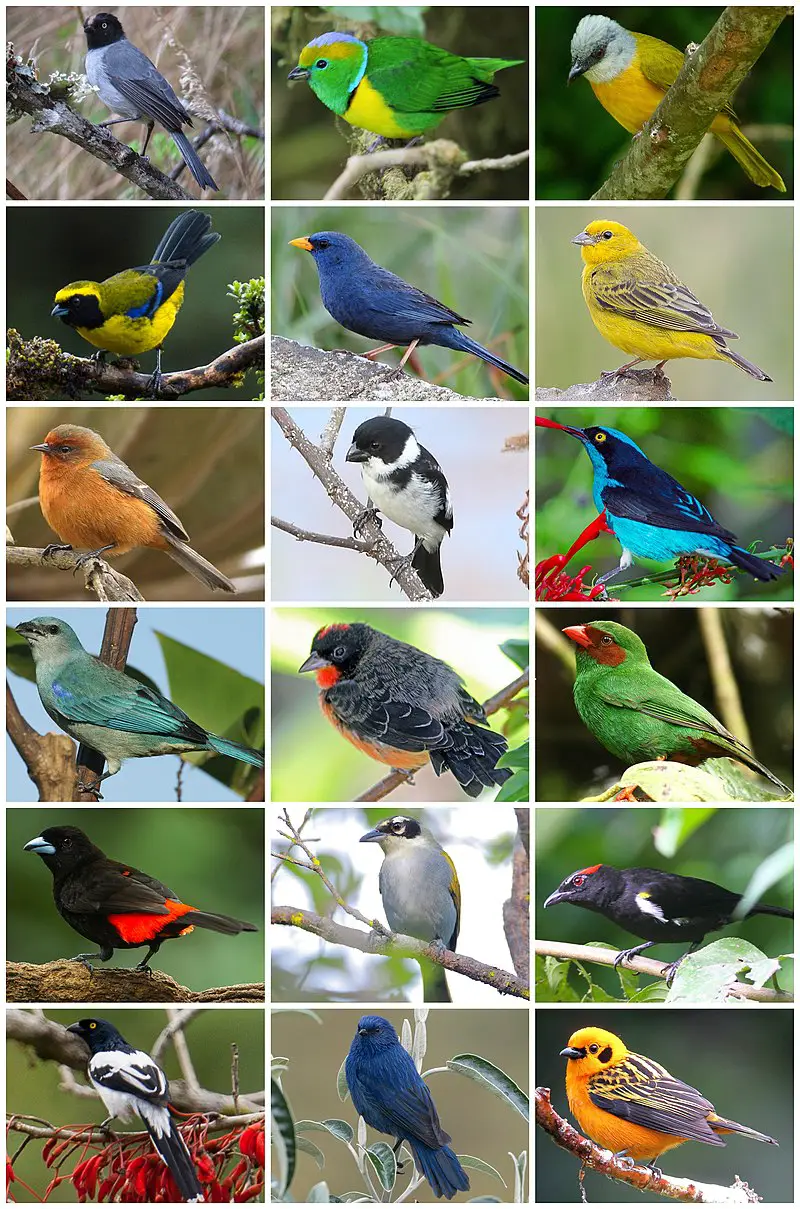
The Tanagers are a beautiful and diverse family of birds native to the Neotropical region. They boast an impressive array of colors, including blues, greens, yellows and reds.
The most common type is the fruit-eating tanager that can be found in tropical forests across Latin America. With nearly 240 species worldwide, they represent almost 4% of all avian species.
These vibrant birds have adapted well to their environment due to their strong bills used for cracking open hard fruits as well as sharp claws for gripping branches while feeding or perching.
As with many other bird families there is natural variation among populations making each one unique in its own way; something that makes them even more special.Scientific classification:
| Kingdom | Animalia |
| Phylum | Chordata |
| Class | Aves |
| Order | Passeriformes |
| Superfamily | Emberizoidea |
| Family | Thraupidae Cabanis, 1847 |
5. Jacamars
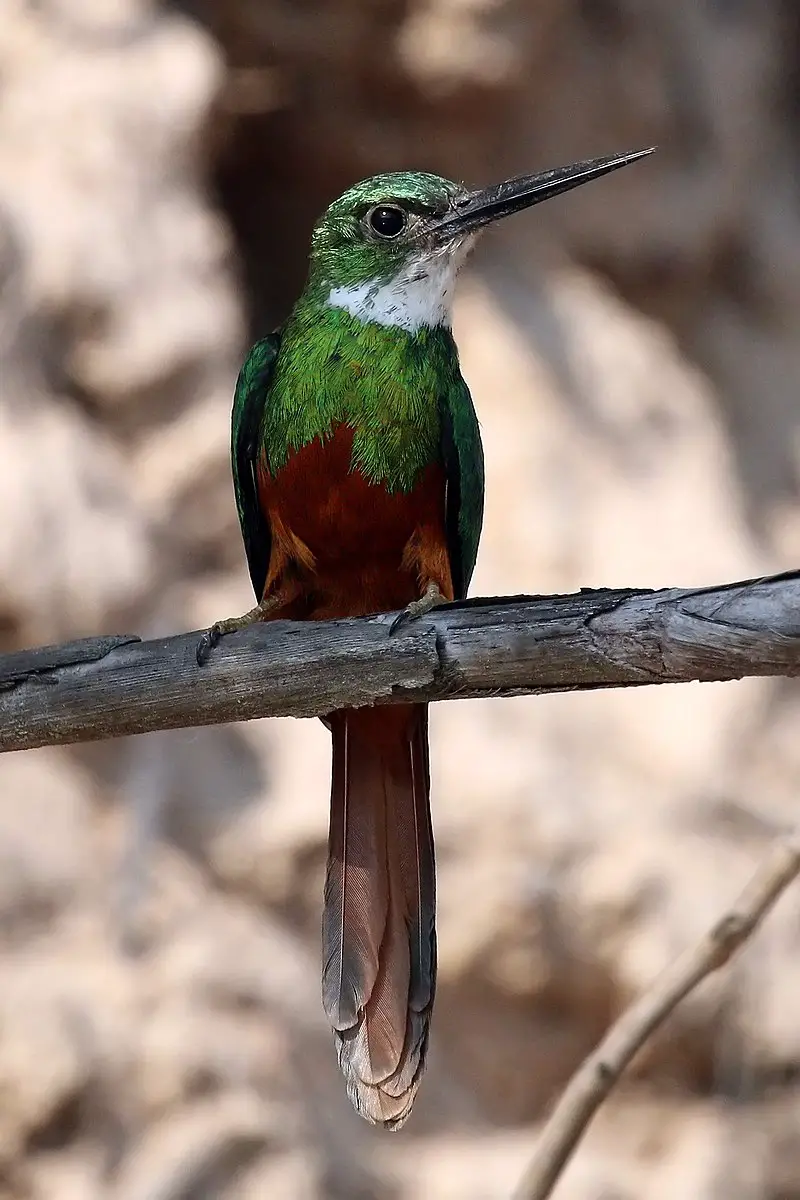
Jacamars are tropical birds native to South and Central America, extending as far north as Mexico. They belong to the Galbulidae family which consists of five genera and eighteen species in total.
These captivating birds can be easily distinguished by their unique appearance; they have long sharp bills with bright vivid plumage ranging from blues, greens and yellows that create a beautiful contrast against the lush vegetation of their natural habitat.
Jacamars prefer to inhabit dense forested areas near rivers or streams where they use their agile wings for quick flight maneuvers while hunting insects, lizards and frogs.
With an unmistakable presence these fascinating feathered creatures make a remarkable addition to any backyard bird sanctuary.Scientific classification:
| Kingdom | Animalia |
| Phylum | Chordata |
| Class | Aves |
| Order | Piciformes |
| Suborder | Galbuli |
| Family | Galbulidae Vigors, 1825 |
6. Cotinga
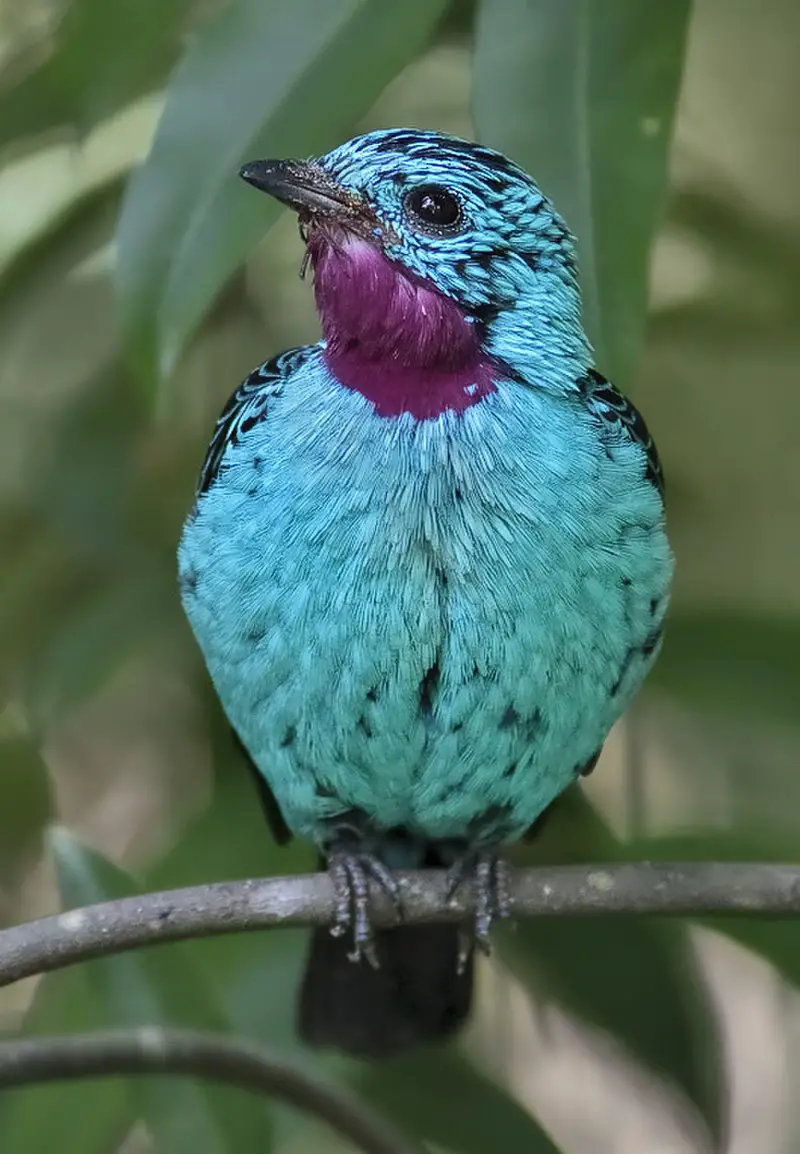
Cotingas are a large family of passerine birds that inhabit Central and South America. They have broad bills with hooked tips, rounded wings, and strong legs.
These colorful birds usually live in forests or forest edges and feed mainly on fruits. Cotinga species range from 12-13 cm (4.7–5.1 inches) to 48-51 cm long depending on the type of bird.
The fiery-throated fruiteater is among the smallest members while others like cocks -of –the rock can reach up to 51cm long.
All these birds display spectacular colors which makes them popular amongst bird watchers all over the world..Scientific classification:
| Kingdom | Animalia |
| Phylum | Chordata |
| Class | Aves |
| Order | Passeriformes |
| Parvorder | Tyrannida |
| Family | Cotingidae Bonaparte, 1849 |
7. Trogon
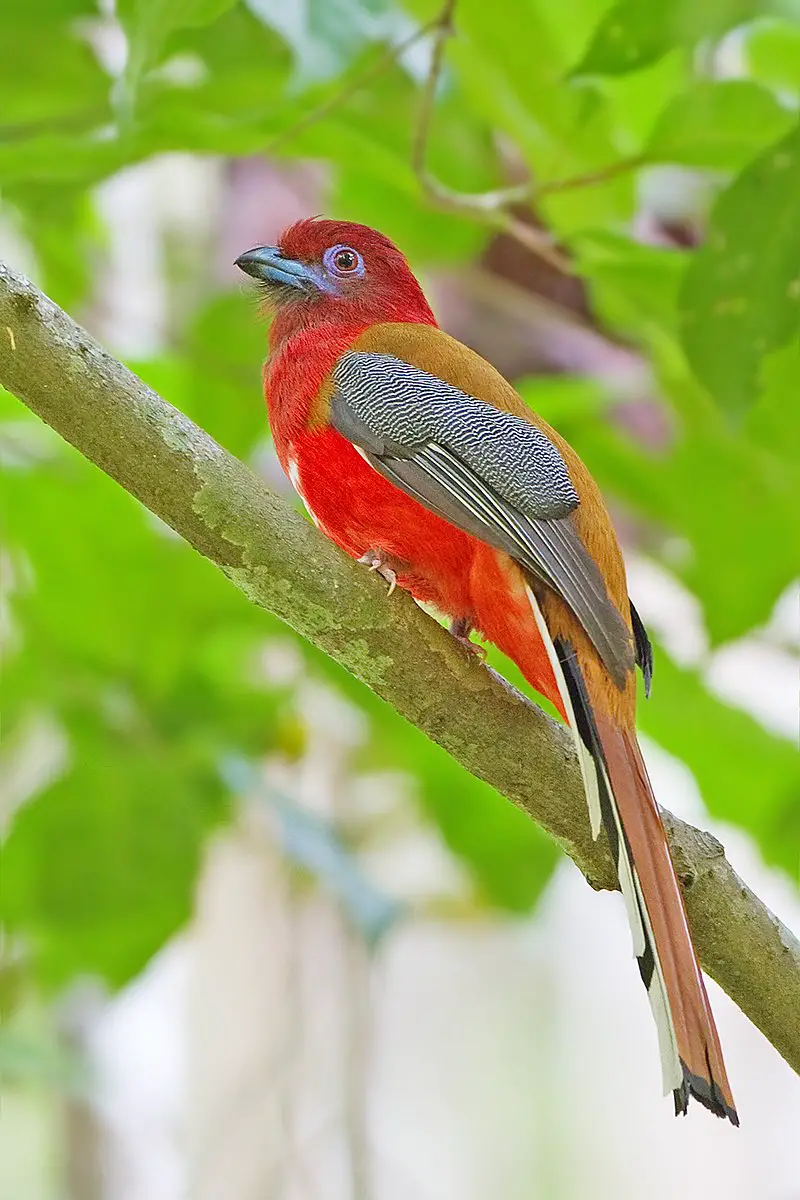
Trogons are a unique bird species that can be found all over the world. They belong to the order Trogoniformes and have only one family, called Trogonidae, which consists of 46 species in seven genera.
Fossil records show that trogons existed 49 million years ago during the Early Eocene period. It is believed they may be closely related or form part of two other orders: Coraciiformes and Passerines.
These birds typically have brightly colored feathers with some having iridescent colors on their wings and tails as well as red bellies and breasts.
Their diet mainly consists of fruit, insects, lizards and frogs but larger ones will also feed on small mammals such as mice or bats.
The most famous member from this group is Quetzalcoatlus – an extinct giant pterosaur which lived approximately 70-65 million years agoScientific classification:
| Kingdom | Animalia |
| Phylum | Chordata |
| Class | Aves |
| Clade | Cavitaves |
| Clade | Eucavitaves |
| Order | Trogoniformes AOU, 1886 |
| Family | Trogonidae Lesson, 1828 |
8. Anhinga
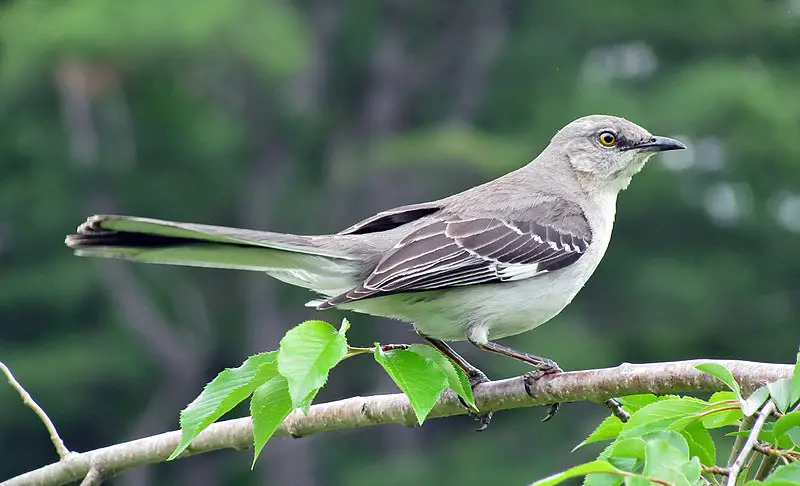
Anhinga birds are a species of water bird commonly found in tropical and subtropical climates.
They have long, slender necks that allow them to plunge their heads underwater without lifting the rest of their bodies out of the water.
Their wings are adapted for fast flight over open waters, as well as gliding on thermals. These birds also possess sharp pointed beaks which they use to spear fish and other prey beneath the surface.
Anhingas are typically black or dark brown with white patches around their eyes and neck area.
Males can reach up to 3 feet tall while females tend to be slightly smaller at 2 1/2 feet in height when fully grown.
These majestic creatures usually live near shallow wetlands where there is plenty of food such as small fishes and amphibians available for them hunt down easily
Also Featured In: Birds that Live in Guyana,
9. New World Barbet
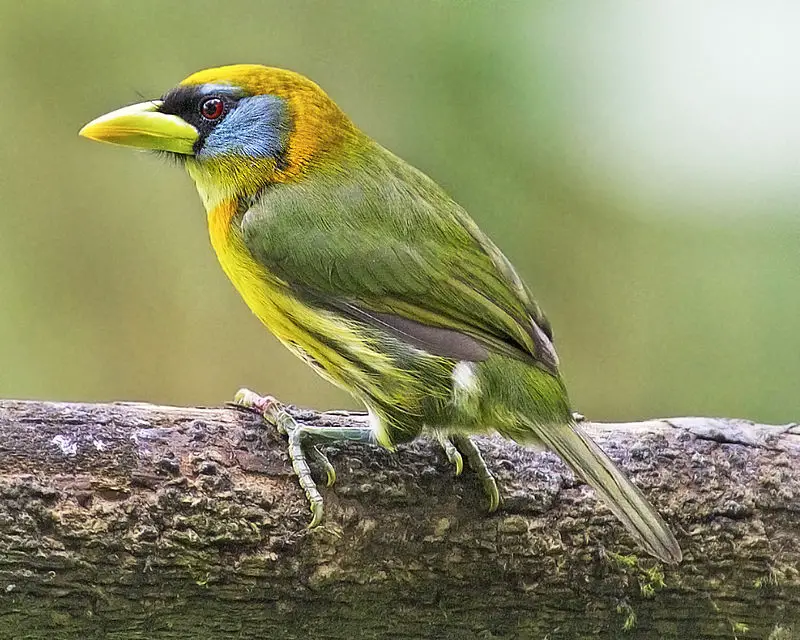
New World barbets are beautiful birds belonging to the family Capitonidae and order Piciformes, found in humid forests of Central America and South America.
They have a plump body with short necks and large heads covered by bristles around their heavy bills.
These brightly coloured creatures inhabit tropical forests, making them an exciting sight for bird watchers.
The diet of these birds mainly consists of fruits from trees such as figs or other soft-bodied insects like caterpillars which they feed on using their strong beaks.
Barbets are usually seen alone but can also form small flocks when searching for food sources together or during migration periods between different locations within the same region.
Although not much is known about New World barbet breeding habits, it has been observed that they nest in cavities formed inside tree trunks or branches close to where food sources are abundant throughout the year.
This helps ensure successful offspring growth even during harsh weather conditions experienced at times.Scientific classification:
| Kingdom | Animalia |
| Phylum | Chordata |
| Class | Aves |
| Order | Piciformes |
| Infraorder | Ramphastides |
| Family | Capitonidae Bonaparte, 1838 |
10. Motmot
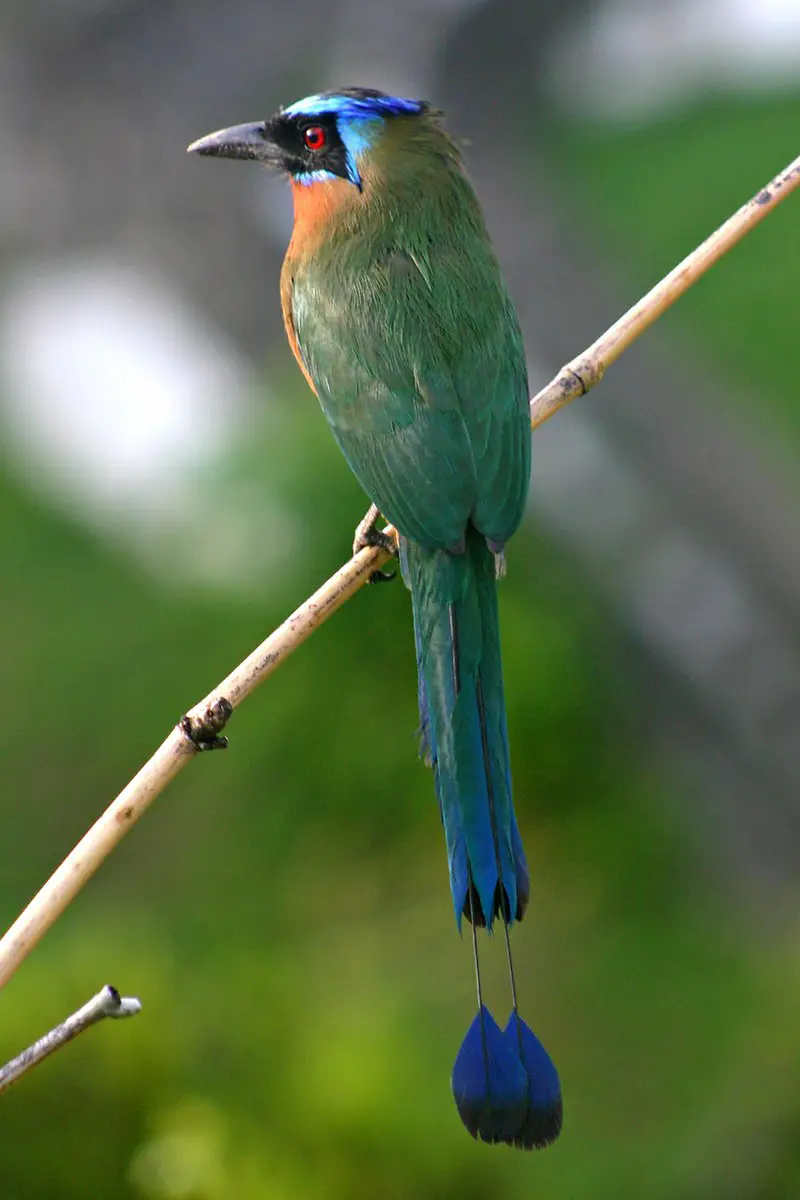
Motmots are a family of birds in the order Coraciiformes, known for their vibrant plumage and relatively heavy bills. They inhabit woodlands or forests across the Neotropics and can range in size from small to large.
The most distinctive feature of motmot species is their long tail feathers that some have adorned with unique patterns like eyespots.
Their diet consists mainly of insects but they will also eat smaller vertebrates such as lizards, frogs and fish.
Motmots are active during daylight hours where they can be seen perching on branches along forest edges or flitting through trees hunting prey.
These beautiful creatures have become an important part of many peoples’ lives throughout Latin America due to them being considered symbols of good luck by local cultures.Scientific classification:
| Kingdom | Animalia |
| Phylum | Chordata |
| Class | Aves |
| Order | Coraciiformes |
| Family | Momotidae GR Gray, 1840 |
11. Puffbird
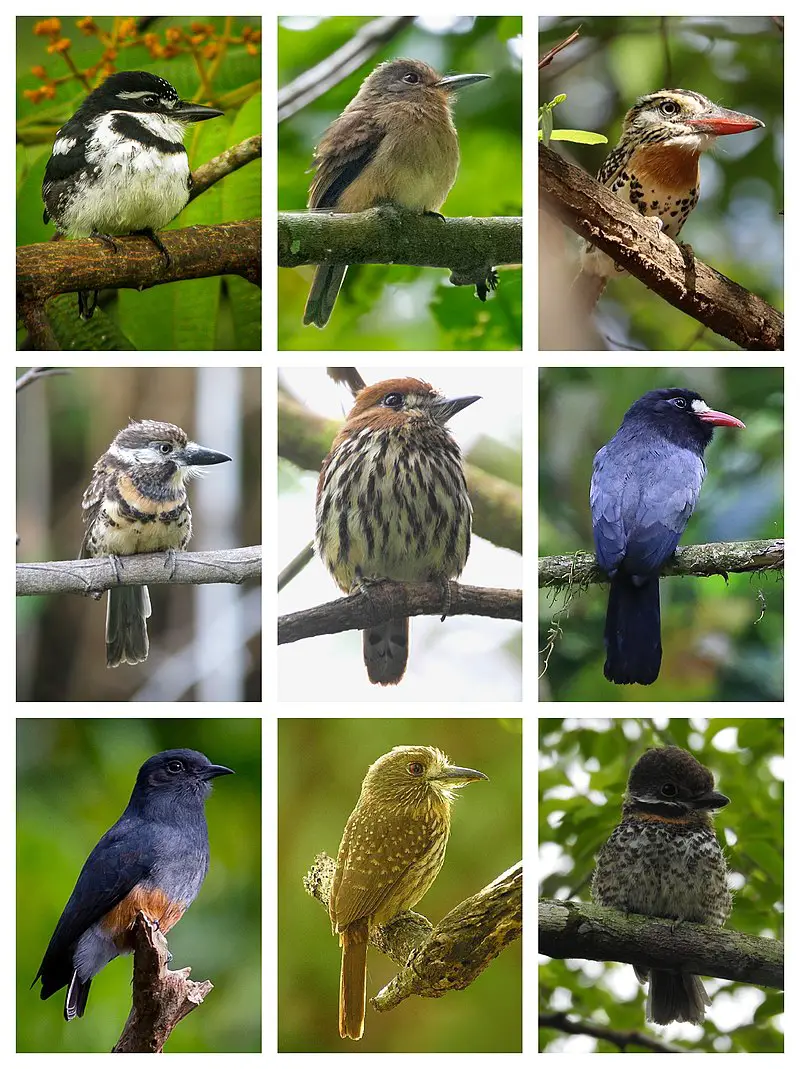
The Puffbird is a tropical tree-dwelling bird found in South America, Mexico and Central America.
It belongs to the near passerine family Bucconidae, which also includes jacamars – its closest relatives.
The order Piciformes unites these two families although some consider them separate under Galbuliformes.
Unlike other birds of the same group that have dazzling iridescent feathers, puffbirds are more modestly coloured with their greyish brown plumage blending into their environment for camouflage purposes when perched on trees or shrubs searching for insects as food sources using their long pointed bill.
They can be quite difficult to spot due to being small and well camouflaged but they may give away their presence by calling out loudly with an unmistakable whistling soundScientific classification:
| Kingdom | Animalia |
| Phylum | Chordata |
| Class | Aves |
| Order | Piciformes |
| Suborder | Galbuli |
| Family | Bucconidae Horsfield, 1821 |
12. Chestnut-Bellied Seed Finch
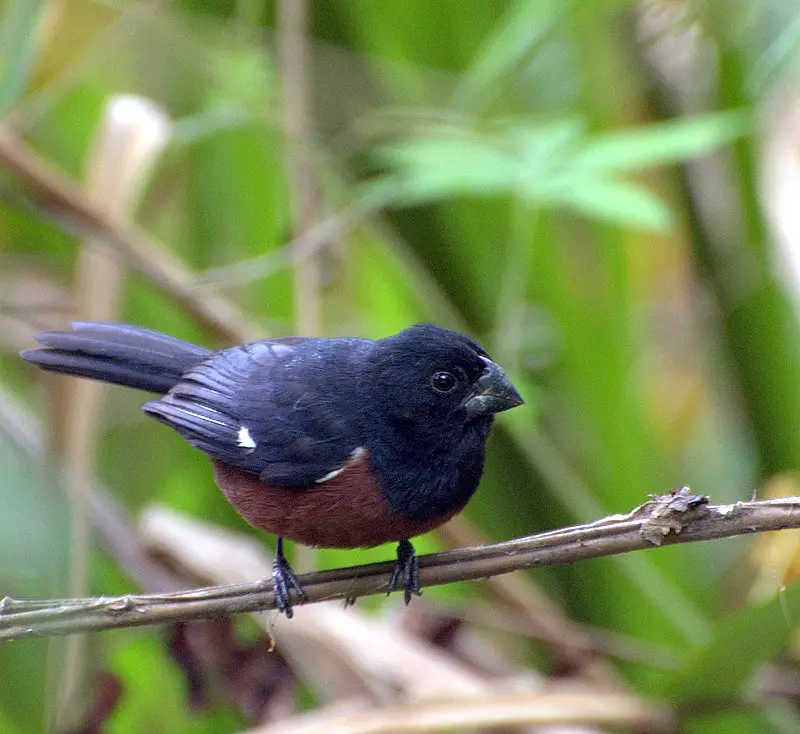
The Chestnut-bellied Seed Finch is a species of bird belonging to the Thraupidae family, recently switched from Emberizidae.
It can be found in tropical and subtropical South America, mainly inhabiting shrubby and grassy areas.
However it has been replaced west of the Andes by its close relative Thick-billed Seed Finch (S. funerea).
These two birds have often been thought as one single species due to their similar characteristics such as size, coloration or song composition; but are now known apart after being studied more deeply.
The Chestnut-bellied seed finch usually feeds on small seeds which they find on vegetation ground both alone or in pairs while also consuming some insects occasionally during breeding season.Scientific classification:
| Kingdom | Animalia |
| Phylum | Chordata |
| Class | Aves |
| Order | Passeriformes |
| Family | Thraupidae |
| Genus | Sporophila |
| Species | S. angolensis |
13. Wattled Jacana
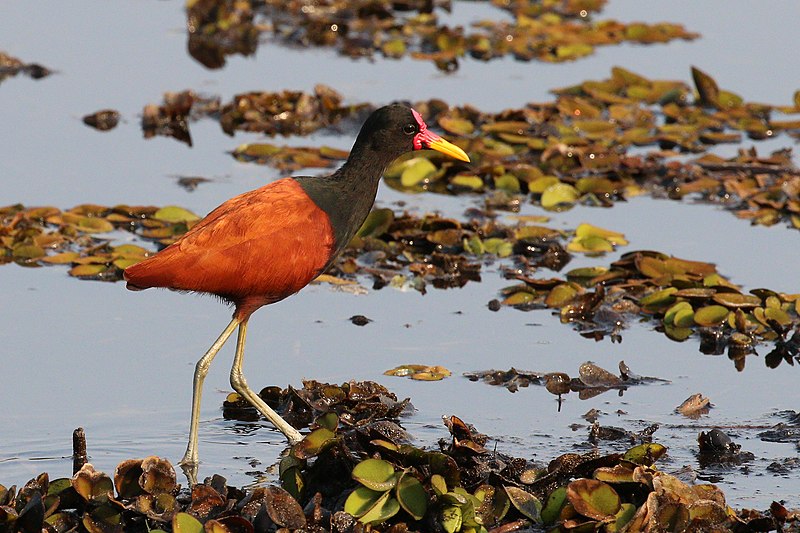
The Wattled Jacana is a stunning bird from central and south America. It has long legs, a black head with yellow wattles at each side, and striking chestnut brown wings.
This wader builds its nest on the surface of ponds or lakes using floating vegetation such as lily pads to anchor it in place – usually with four eggs that are darkly marked.
The male takes primary responsibility for incubation of these eggs between his wings, while the female will take care of her chicks once they hatch out.
These birds feed mainly on aquatic insects but also small fish and amphibians if available.
Overall this species is an interesting and attractive addition to any wetland habitat.Scientific classification:
| Kingdom | Animalia |
| Phylum | Chordata |
| Class | Aves |
| Order | Charadriiformes |
| Family | Jacanidae |
| Genus | Jacana |
| Species | J. jacana |
14. Guianan Cock-Of-The-Rock
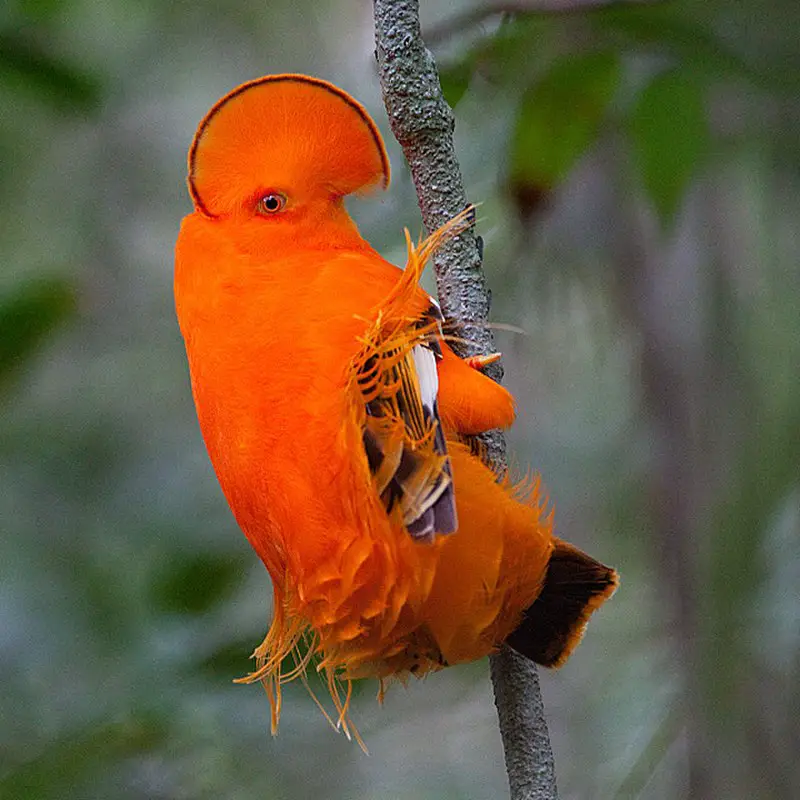
The Guianan cock-of-the-rock is an impressive South American bird, with the male having a striking orange and black plumage.
This cotinga species can be found in tropical rainforests near rocky outcrops, usually measuring about 30 cm (12 in) long and weighing around 200 to 220 g (7.1 to 7.8 oz).
The female’s feathers are brownish/dark smokey grey – generally less noticeable than the males due to their bright colours.
These birds have also been known for their unusual courtship displays involving loud calling and bowing which take place on exposed rocks or branches of tall trees.
Their diet consists mainly of fruits supplemented by invertebrates such as insects, spiders, millipedes and centipedes that they capture while flying through the canopy layer.
All in all, these beautiful creatures will make sure you never forget them after seeing one.Scientific classification:
| Kingdom | Animalia |
| Phylum | Chordata |
| Class | Aves |
| Order | Passeriformes |
| Family | Cotingidae |
| Genus | Rupicola |
| Species | R. rupicola |
15. Southern Lapwing
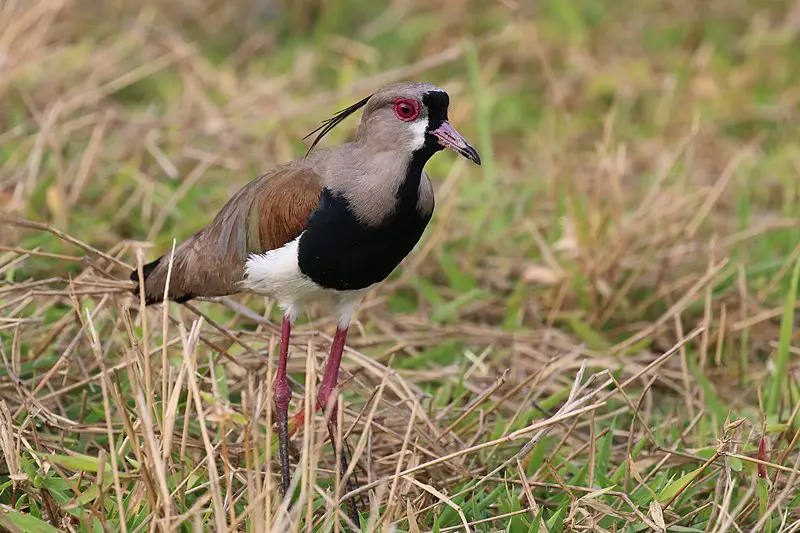
The Southern lapwing, also known as quero-quero in Brazil or tero in Argentina and Uruguay, is a wader that can be found throughout South America.
It inhabits open areas like grasslands and fields but avoids heavily forested regions such as the Amazon basin.
This bird has an unmistakable appearance with its black-and-white plumage contrasting against its bright yellow bill and legs.
The male’s feathers are more vibrant than those of the female, making them easily distinguishable from each other.
They feed on worms and insects which they search for by probing their long bills into soft ground while walking around looking for food.
Lapwings are highly territorial birds who will protect their nests fiercely from any potential predators or intruders.Scientific classification:
| Kingdom | Animalia |
| Phylum | Chordata |
| Class | Aves |
| Order | Charadriiformes |
| Family | Charadriidae |
| Genus | Vanellus |
| Species | V. chilensis |
16. Tropical Kingbird
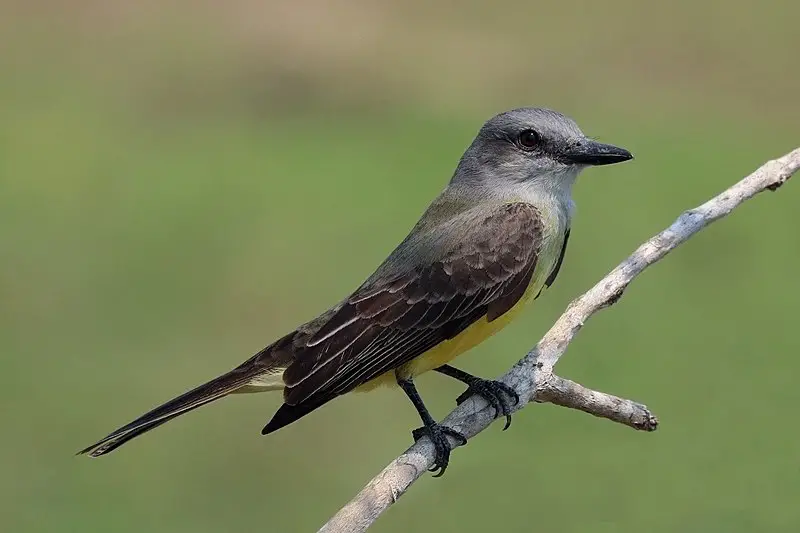
The Tropical Kingbird is an impressive bird, native to the Americas. It’s a large tyrant flycatcher that breeds in southern Arizona and Texas through Central America and down south as far as Argentina and Peru.
This species also lives on Trinidad & Tobago islands. During cold winter months, most of them migrate to warmer climates within its range.
They inhabit open areas such as fields or forests with scattered trees – but away from heavily wooded habitats.
In terms of diet, they mainly feed upon insects which are caught by hawking from perches or snatching up in flight; however it will occasionally eat fruits too.
The adult has grey-brown upperparts, darker wings edged with yellowish feathers plus a white breast band contrasting against pale orange underparts for both sexes.
A conspicuous black mask runs across their eyes completing this beautiful bird’s look.Scientific classification:
| Kingdom | Animalia |
| Phylum | Chordata |
| Class | Aves |
| Order | Passeriformes |
| Family | Tyrannidae |
| Genus | Tyrannus |
| Species | T. melancholicus |
17. Tinamou

Anhinga birds are a species of water bird commonly found in tropical and subtropical climates.
They have long, slender necks that allow them to plunge their heads underwater without lifting the rest of their bodies out of the water.
Their wings are adapted for fast flight over open waters, as well as gliding on thermals. These birds also possess sharp pointed beaks which they use to spear fish and other prey beneath the surface.
Anhingas are typically black or dark brown with white patches around their eyes and neck area.
Males can reach up to 3 feet tall while females tend to be slightly smaller at 2 1/2 feet in height when fully grown.
These majestic creatures usually live near shallow wetlands where there is plenty of food such as small fishes and amphibians available for them hunt down easily
18. Falconiformes
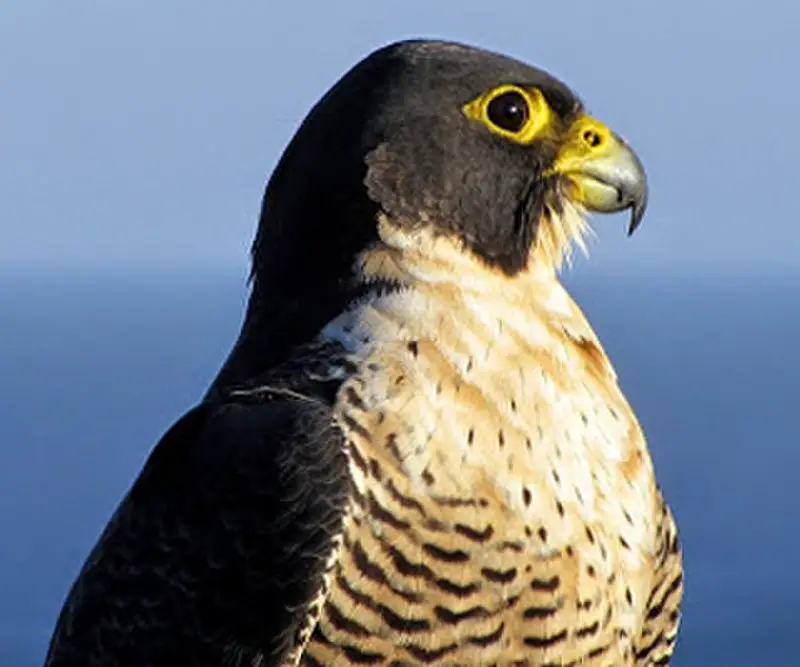
Falconiformes is an order of birds that includes the family Falconidae, which consists of falcons and caracaras. Additionally, there are handfuls of mysterious species from the Paleogene era.
Traditionally, other bird-of-prey families like Cathartidae (New World vultures and condors), Sagittariidae (secretarybird), Pandionidea (ospreys) and Accipitridae (hawks) were also classified as members in this group.
Advances in comparative genomics have allowed for a more thorough understanding not just about these unique species but their relationships with one another too.Scientific classification:
| Kingdom | Animalia |
| Phylum | Chordata |
| Class | Aves |
| Clade | Eufalconimorphae |
| Order | Falconiformes Sharpe, 1874 |
19. Tropical Mockingbird
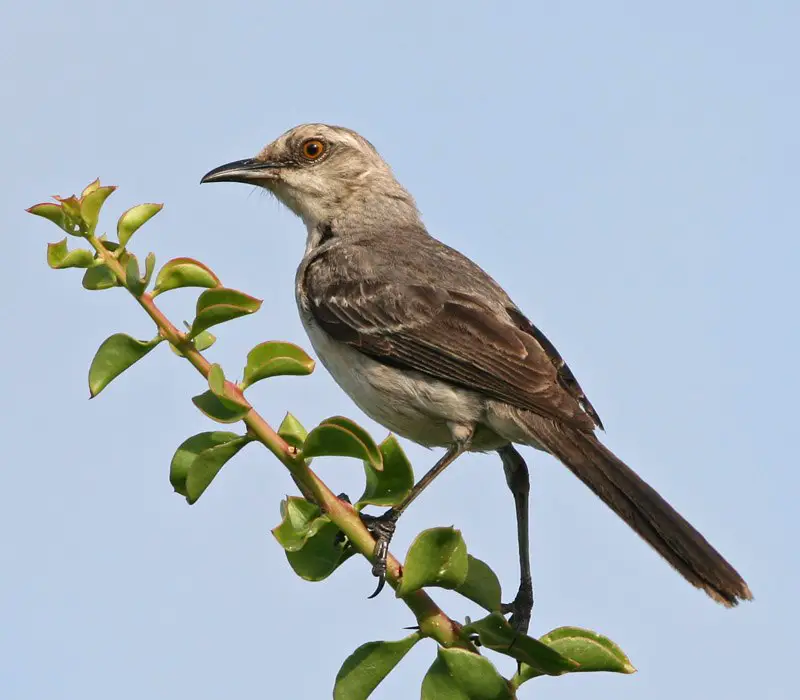
The Tropical mockingbird is a species of bird found throughout Central America and the Caribbean. It has been classified as a resident breeding bird, with its range stretching from southern Mexico to northern and eastern South America.
This species is closely related to the Northern Mockingbird, forming what is known as a superspecies between them both.
The Tropical mockingbird can be recognized by its grey-brown coloration on top, blending into white underparts which are highlighted by black spots along their throat and wings.
They have long legs for perching in trees or shrubs while searching for prey such as insects before singing out melodic songs during territorial disputes with other birds in the area.
Sadly, one subspecies -the San Cristobal Mockingbird – has been listed as critically endangered due to habitat destruction caused by human activities including logging within their natural environment.Scientific classification:
| Kingdom | Animalia |
| Phylum | Chordata |
| Class | Aves |
| Order | Passeriformes |
| Family | Mimidae |
| Genus | Mimus |
| Species | M. gilvus |
20. Red Siskin
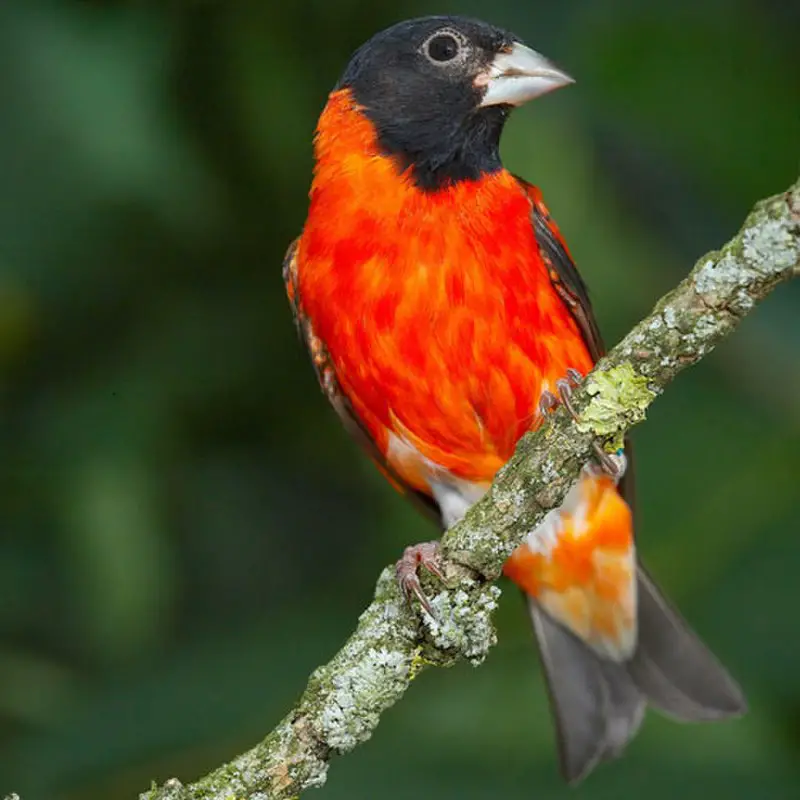
The Red Siskin is a vibrant and unique bird native to tropical South America. It has been found in northern Colombia, Venezuela (where it’s known as the “cardenalito”) and Guyana.
In the early 20th century, this species was plentiful throughout its range but due to human activity, it has become increasingly rare. Its population on Trinidad is likely extinct now.
The male red siskin sports bright orange-red feathers with black wings and tail while females are duller yellowish green overall with dark streaks along their head, back and chest area.
These birds feed primarily on seeds from grasses or small fruits such as mulberry or banana trees found near forests edges during migration season when they travel between countries in flocks of up to 15 individuals.Scientific classification:
| Kingdom | Animalia |
| Phylum | Chordata |
| Class | Aves |
| Order | Passeriformes |
| Family | Fringillidae |
| Subfamily | Carduelinae |
| Genus | Spinus |
| Species | S. cucullatus |
21. Skimmers
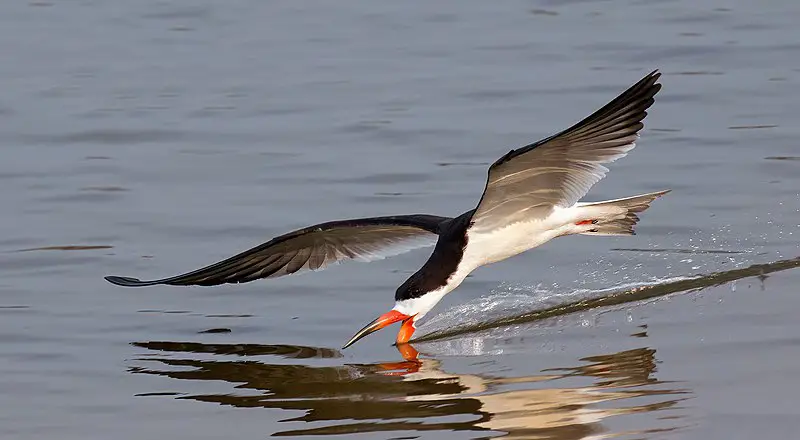
Skimmers are tern-like birds in the family Laridae, with three species found in South Asia, Africa, and Americas.
They were formerly known as scissorbills due to their distinctive uneven bills where the lower mandible is longer than the upper.
This adaptation allows them to feed by flying low over water while skimming its surface for fish or insects with open bill. Skimmers have a unique ability of pouncing on prey too which adds to their impressive hunting skillset.
Their wingspan ranges from 27″ – 37″, depending on species and they come in shades of white/grey/brown plumage that helps camouflage against predators.
All these characteristics make them an interesting bird worth studying and observing.Scientific classification:
| Kingdom | Animalia |
| Phylum | Chordata |
| Class | Aves |
| Order | Charadriiformes |
| Family | Laridae |
| Genus | Rynchops Linnaeus, 1758 |
22. Black Curassow
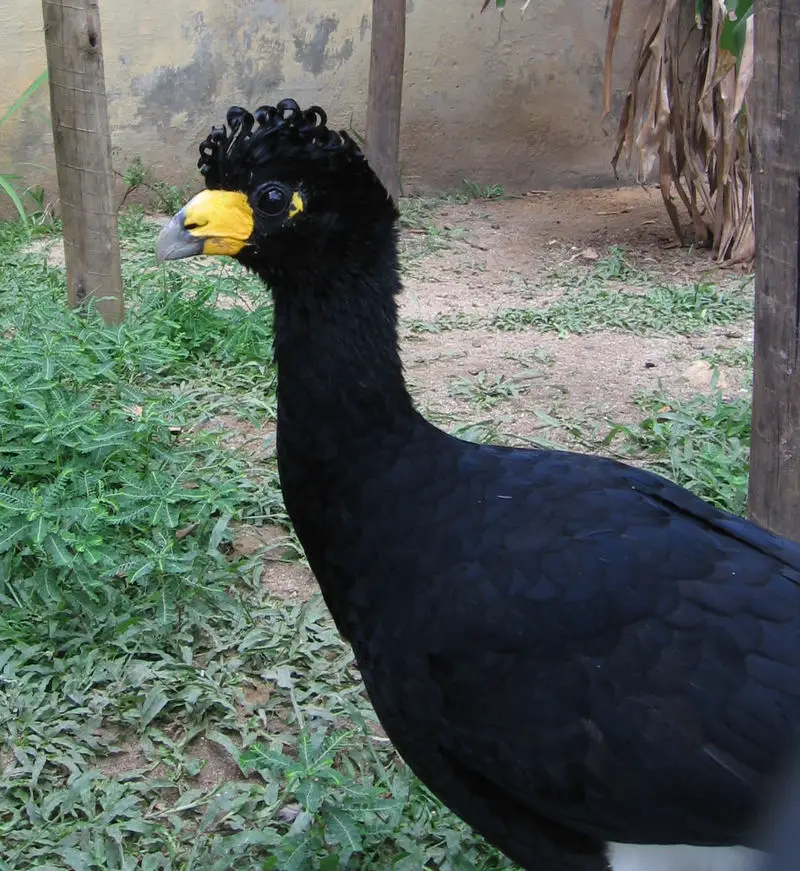
The Black Curassow is a species of bird that belongs to the Cracidae family. It inhabits humid forests in northern South America, including Colombia, Venezuela and Brazil.
This majestic bird can also be found further north on certain Caribbean islands such as Cuba, Jamaica, Haiti and Puerto Rico.
The adult has an overall black plumage with white scapulars adorning its mantle while males have a glossy blue-black head ornamented by two curved yellow casques on either side of their heads.
They are quite large birds reaching up to 75 cm (30 inches) long and weighing 2 kg (4 lbs).
Despite being hunted for food or trade purposes they remain fairly common across much of their range but due to deforestation numbers may decrease in future years .Scientific classification:
| Kingdom | Animalia |
| Phylum | Chordata |
| Class | Aves |
| Order | Galliformes |
| Family | Cracidae |
| Genus | Crax |
| Species | C. alector |
23. Manakin
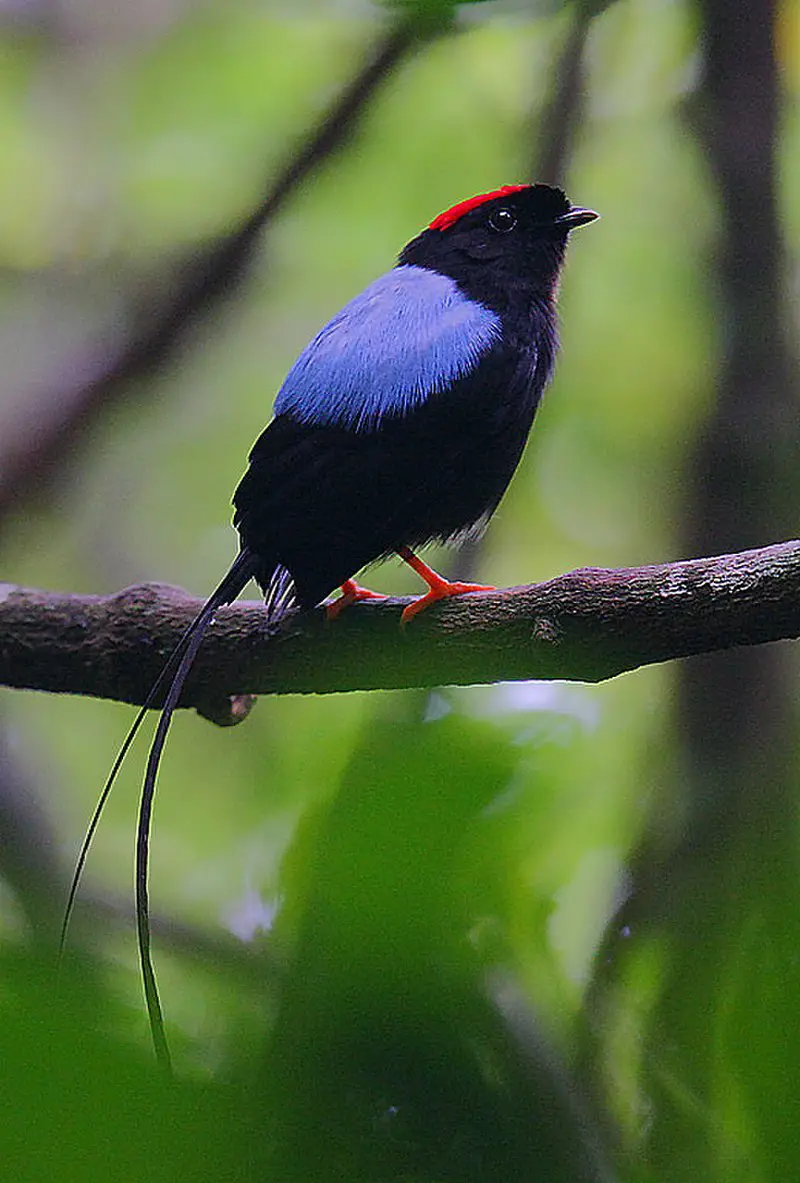
Manakins are a family of small, suboscine passerine birds found in the American tropics. They measure between 7 to 15 cm and weigh between 8-30 gm.
Some 54 species have been identified so far, all belonging to genus Tyranneutes which is characterized by their bright feather colors and unique courtship behaviors like hopping or fluttering around female manakin.
The name ‘manakin’ has its origin from Middle Dutch word ‘mannekijn’ meaning little man – aptly describing these vibrant feathered creatures.
Although they inhabit different habitats including forests, woodlands etc., some species remain threatened due to habitat destruction and fragmentation.Scientific classification:
| Kingdom | Animalia |
| Phylum | Chordata |
| Class | Aves |
| Order | Passeriformes |
| Parvorder | Tyrannida |
| Family | Pipridae Rafinesque, 1815 |
24. Caprimulgiformes

Anhinga birds are a species of water bird commonly found in tropical and subtropical climates.
They have long, slender necks that allow them to plunge their heads underwater without lifting the rest of their bodies out of the water.
Their wings are adapted for fast flight over open waters, as well as gliding on thermals. These birds also possess sharp pointed beaks which they use to spear fish and other prey beneath the surface.
Anhingas are typically black or dark brown with white patches around their eyes and neck area.
Males can reach up to 3 feet tall while females tend to be slightly smaller at 2 1/2 feet in height when fully grown.
These majestic creatures usually live near shallow wetlands where there is plenty of food such as small fishes and amphibians available for them hunt down easily
25. Rufescent Tiger Heron
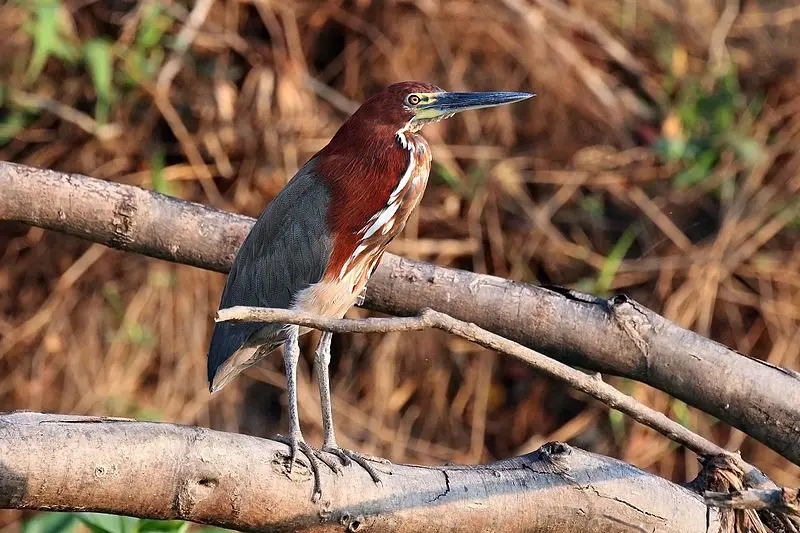
The Rufescent Tiger Heron is a species of heron found in wetlands from Central America to South America. It was first described by the French polymath Georges-Louis Leclerc, Comte de Buffon in 1780.
This majestic bird has a light brown body with dark barring on its wings and tail feathers. Its long beak curves downwards and its legs are yellowish-green.
The head is grayer than the rest of its body, giving it an almost regal appearance when seen in flight or perching atop trees near water bodies like rivers or lakes.
With their striking colours and size – reaching up to 90cm tall – they can easily stand out against other birds.Scientific classification:
| Kingdom | Animalia |
| Phylum | Chordata |
| Class | Aves |
| Order | Pelecaniformes |
| Family | Ardeidae |
| Genus | Tigrisoma |
| Species | T. lineatum |
26. Green-Backed Trogon
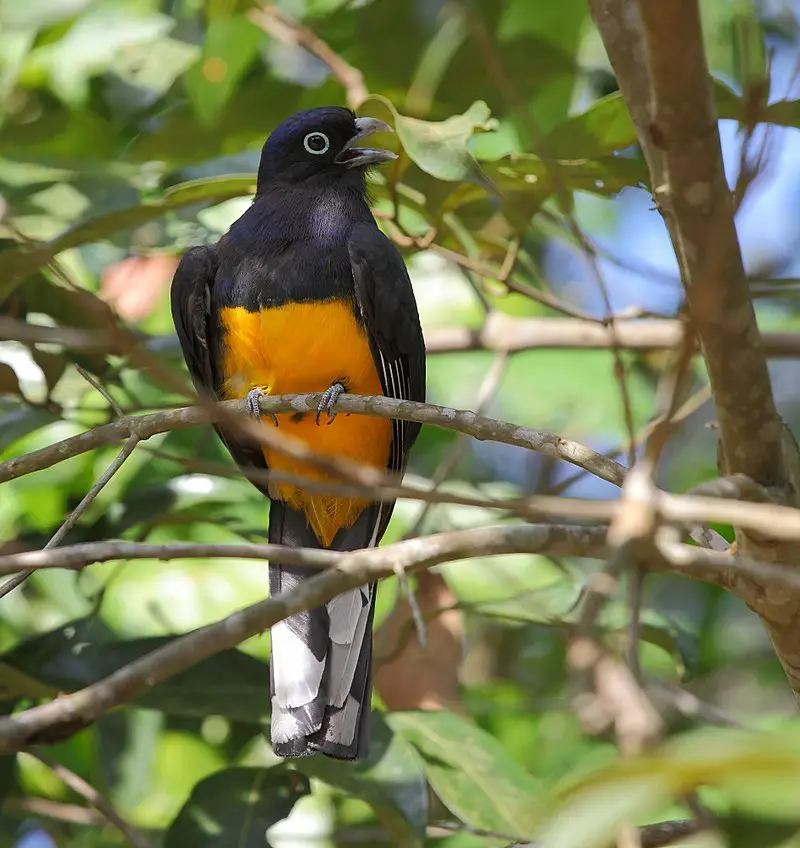
The Green-backed Trogon is a beautiful bird found in the Amazon rainforest and southeast coast of Brazil. It belongs to the trogon family, which are known for their distinct coloration.
The male has bright green upperparts with blue head that transitions into pale yellow on its belly, lacking a white breastband.
Females have brownish upperparts and olive underparts with barring throughout both sexes.
They usually feed on insects such as beetles or grasshoppers while hovering in midair before swooping down to catch prey.
This species can also be seen perched atop tree branches looking out for potential meals. Its vibrant colors make it one of most stunning birds around and an absolute must-see when visiting its natural habitat.Scientific classification:
| Kingdom | Animalia |
| Phylum | Chordata |
| Class | Aves |
| Order | Trogoniformes |
| Family | Trogonidae |
| Genus | Trogon |
| Species | T. viridis |
27. Stone-Curlew

Stone-curlews, also known as dikkops or thick-knees, are a family of birds that have adapted to live in tropical and temperate regions throughout the world.
They can be found in Africa, Asia and Australia with two or more species per region. Despite being classified as waders, most prefer dry arid habitats over moist wetlands.
Stone-curlews typically have long legs which help them navigate through their preferred terrain efficiently; some species even stand at an impressive height when standing on those long legs.
Additionally they feature cryptic plumage which helps them blend into their surroundings while hunting for prey such as insects and small mammals like rodents.
These unique bird’s calls are easily recognizable; it has been said that hearing one is similar to listening to someone whistling ‘Keee Weee’.Scientific classification:
| Kingdom | Animalia |
| Phylum | Chordata |
| Class | Aves |
| Order | Charadriiformes |
| Suborder | Chionidi |
| Family | Burhinidae Mathews, 1912 |
28. Skuas
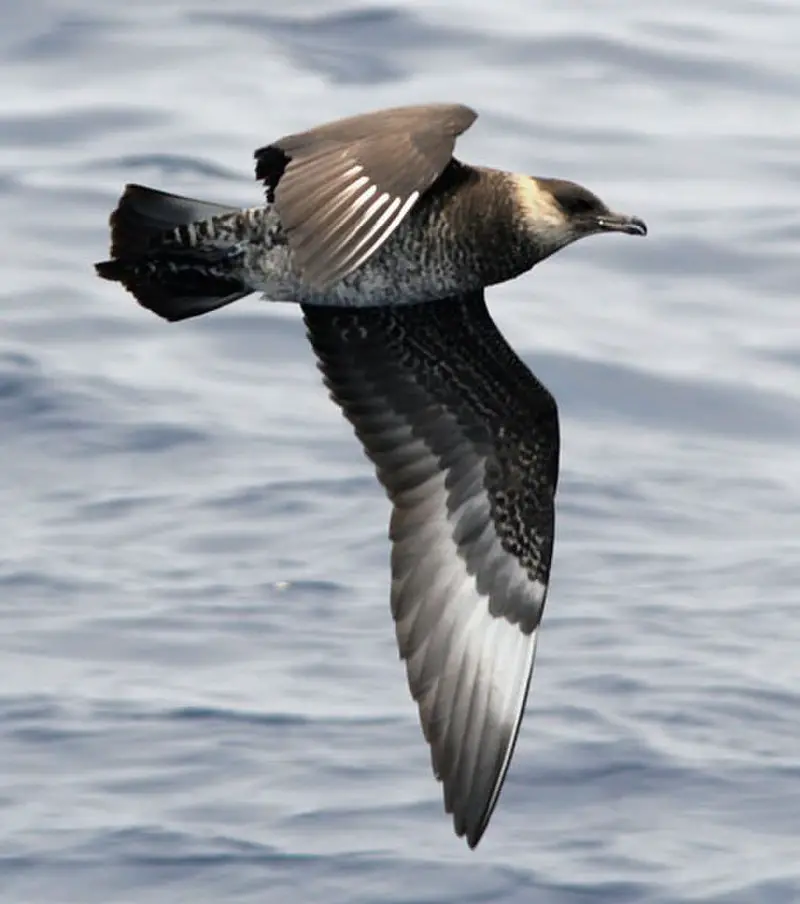
Skuas are a group of predatory seabirds with seven species, all belonging to the genus Stercorarius.
They are also known as “Jaegers” in North America and their name originates from the Faroese word for Great Skua – skúgvur.
These birds typically inhabit coastal areas or open oceans where they feed on fish, krill and other marine creatures.
Skuas can be distinguished by their pointed wings which help them fly long distances while hunting food.
Their distinctive colouration varies depending on age and habitat but generally includes greyish brown upperparts and white underparts with black streaks along its belly area.
The overall size ranges from 24-40 cm making these one of the larger sea bird species.Scientific classification:
| Kingdom | Animalia |
| Phylum | Chordata |
| Class | Aves |
| Order | Charadriiformes |
| Suborder | Lari |
| Family | Stercorariidae Gray, 1871 |
| Genus | Stercorarius Brisson, 1760 |
29. Heliornithidae
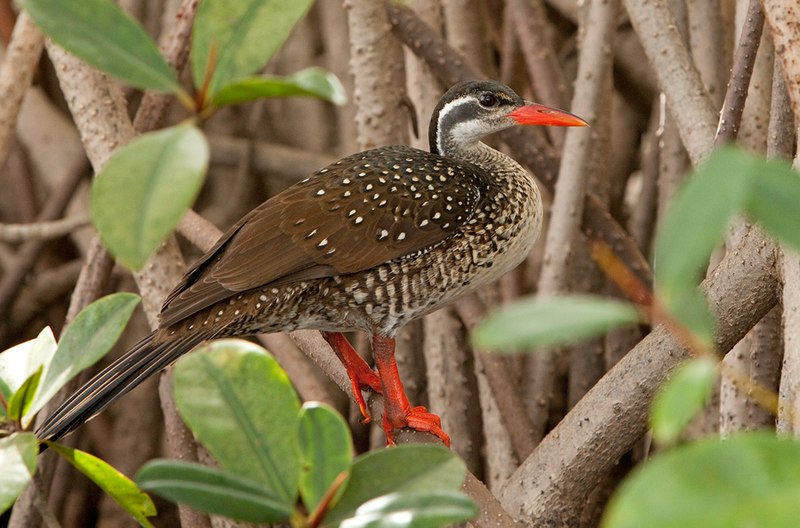
Heliornithidae, commonly known as finfoots, are a small family of tropical birds found in South America and Africa. They have webbed feet like grebes or coots, long necks, slender bodies and broad tails with sharp pointed bills.
Their diverse calls include whistles, squawks and croaks which they use to communicate with each other.
Finfoots feed mainly on fish but also consume insects such as water beetles and dragonflies near the surface of waterbodies.
They nest around rivers or lakes where there is plenty of cover from predators such as eagles or hawks.
During breeding season males can become quite territorial defending their territories against intruders by chasing them off aggressively using loud noises or even physical contact if necessary.Scientific classification:
| Kingdom | Animalia |
| Phylum | Chordata |
| Class | Aves |
| Order | Gruiformes |
| Family | Heliornithidae GR Gray, 1840 |
30. Northern Storm Petrels
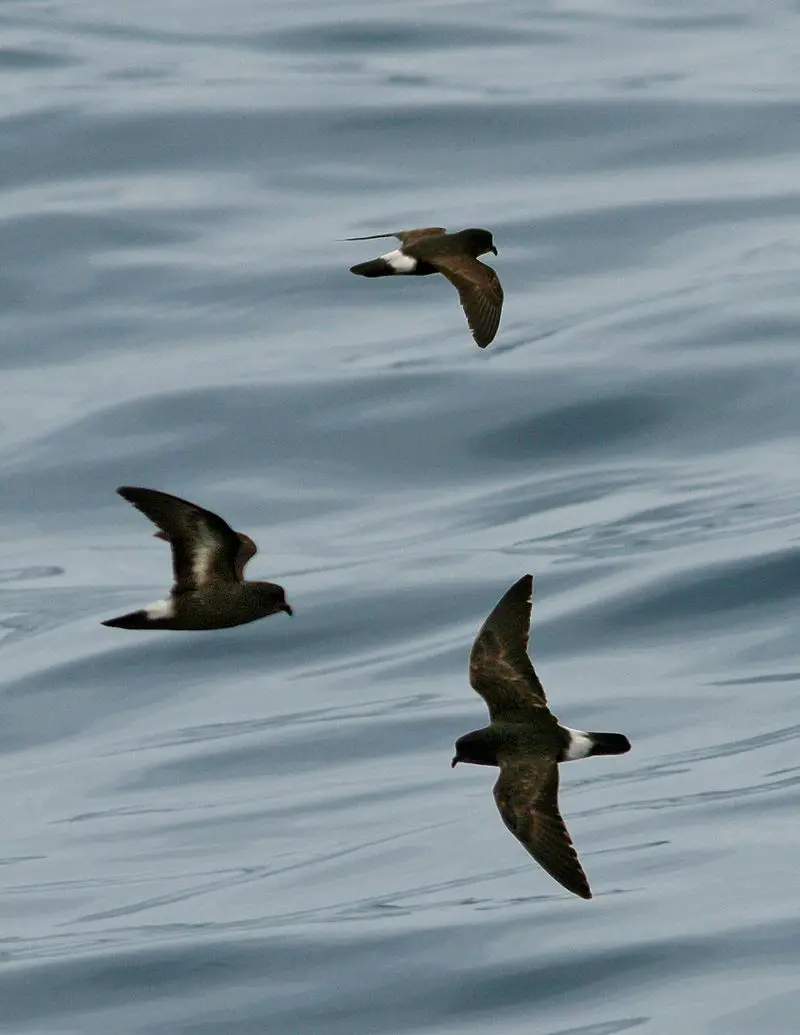
Northern storm petrels are one of the smallest seabirds, inhabiting oceans all over the world.
They have a unique ability to hover over water and pick planktonic crustaceans and small fish from the surface.
Northern storm petrels belong to the genus Hydrobates in family Hydrobatidae, part of Procellariiformes order.
This species was once lumped with austral storm petrel but recent studies show that they weren’t related closely which led them being split into two distinct species now.
These birds can be identified by their dark grey upperparts and wings along with white underparts when seen from afar while feeding on ocean’s surface.Scientific classification:
| Kingdom | Animalia |
| Phylum | Chordata |
| Class | Aves |
| Order | Procellariiformes |
| Family | Hydrobatidae Mathews, 1912 |
| Genus | Hydrobates F. Boie, 1822 |
31. Psophia
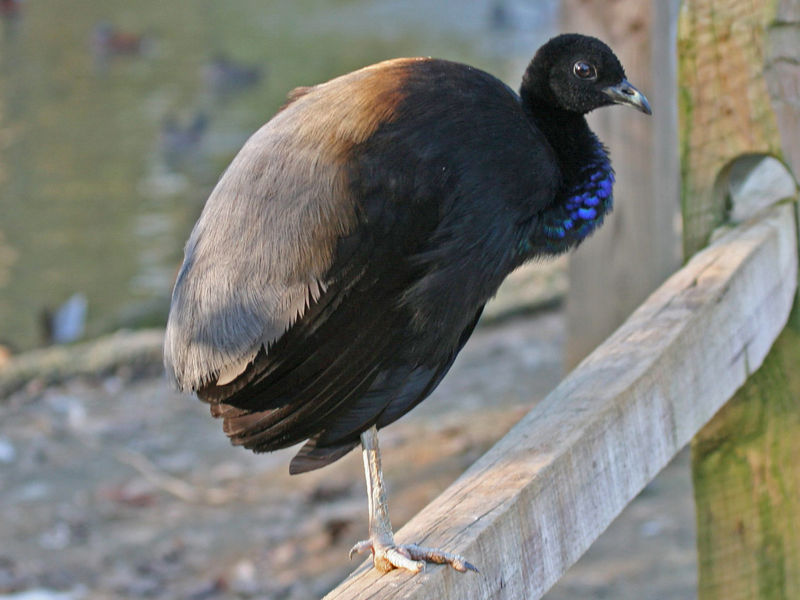
Psophia is a genus of birds found in South America, and are the only members of the Psophiidae family. They have an unmistakable appearance, with their long legs and necks giving them a chicken-like stature.
Males make loud trumpeting or cackling noises when they feel threatened. The three species range from 45 to 52 centimetres (18 to 20 inches) in length, weighing up to 1.5 kg (2 lbs).
They live mainly in humid forests across the Amazon and Guiana Shield regions, where there is plenty for them forage on such as fruit, insects and small animals like lizards or frogs.
These fascinating creatures play an important role within their environment; helping disperse seeds throughout the forest by eating fruits which contain large quantities of seeds that will eventually be spread elsewhere through defecation.Scientific classification:
| Kingdom | Animalia |
| Phylum | Chordata |
| Class | Aves |
| Order | Gruiformes |
| Family | Psophiidae Bonaparte, 1831 |
| Genus | Psophia Linnaeus, 1758 |
32. Ringed Kingfisher
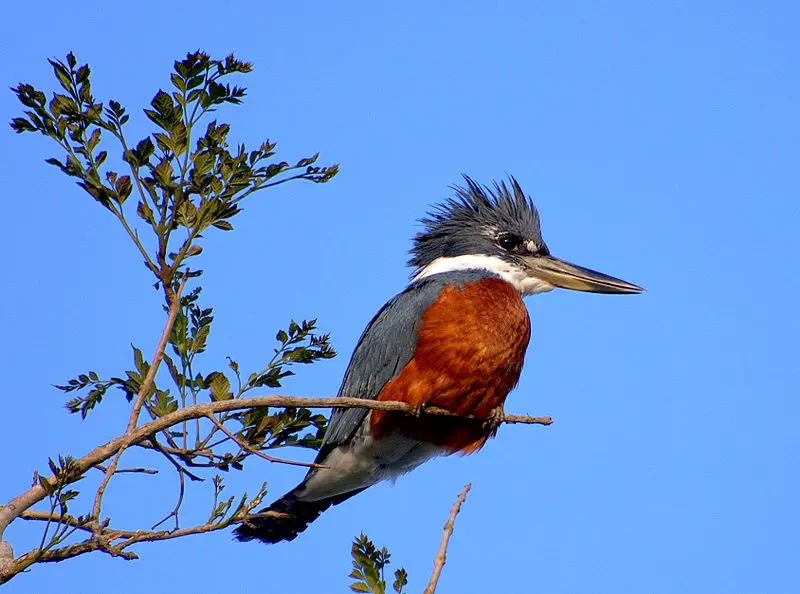
The Ringed Kingfisher is a large, vibrant bird that can be easily noticed by its loud call. It’s found in tropical regions from the lower Rio Grande Valley of southeastern Texas to Central America and even as far south as Tierra del Fuego.
This ground-dwelling species prefers to inhabit open areas near water bodies like streams, rivers and lakes which provide them with plenty of food such as fish, amphibians, crustaceans and insects.
In 1888 it was first identified by ornithologist Frank Chapman who noted its distinct ring pattern on the breast area.
The upperparts are dark blue while underneath they have white spots around their neck and belly region along with pale brown wings tipped in black stripes making this species quite unique among other kingfishers.
They may look intimidating but these birds actually play an important role for humans since they help control insect populations thus helping maintain a healthy balance within our ecosystems.Scientific classification:
| Kingdom | Animalia |
| Phylum | Chordata |
| Class | Aves |
| Order | Coraciiformes |
| Family | Alcedinidae |
| Subfamily | Cerylinae |
| Genus | Megaceryle |
| Species | M. torquata |
33. Buff-Necked Ibis
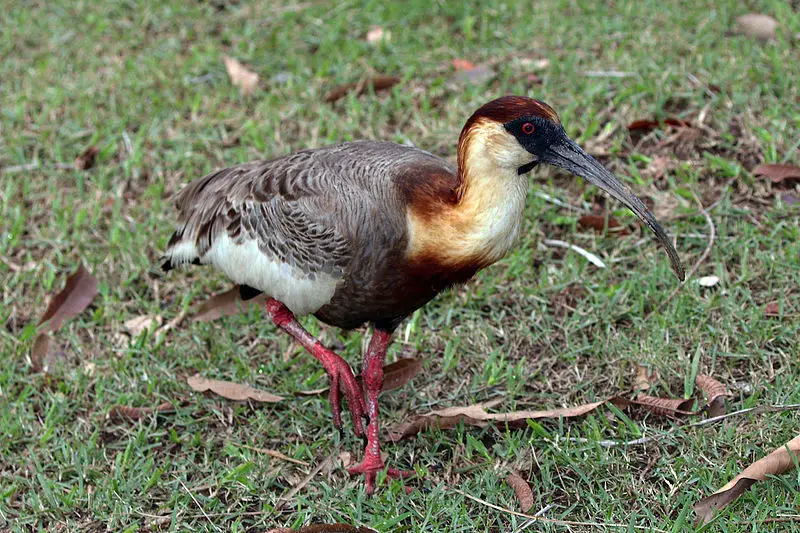
The Buff-necked Ibis is a large bird found in eastern and northern South America. It has grey plumage, with an orange beak and legs, as well as a distinctive white throat.
This striking ibis was previously considered to include the Black-faced Ibis as a subspecies but they have since been recognised as separate species.
The latter having mostly remained at colder regions of South America and featuring buff (not dark grey) lower chest feathers instead.
This bird prefers open habitats such as grasslands, savannahs or marshy areas where it feeds on small insects, lizards or other invertebrates that live among vegetation.
Despite its wide range distribution throughout much of South America this species remains vulnerable due to habitat destruction for agricultural activities which reduces their available food sources significantly.Scientific classification:
| Kingdom | Animalia |
| Phylum | Chordata |
| Class | Aves |
| Order | Pelecaniformes |
| Family | Threskiornithidae |
| Genus | Theristicus |
| Species | T. caudatus |
34. Guianan Toucanet
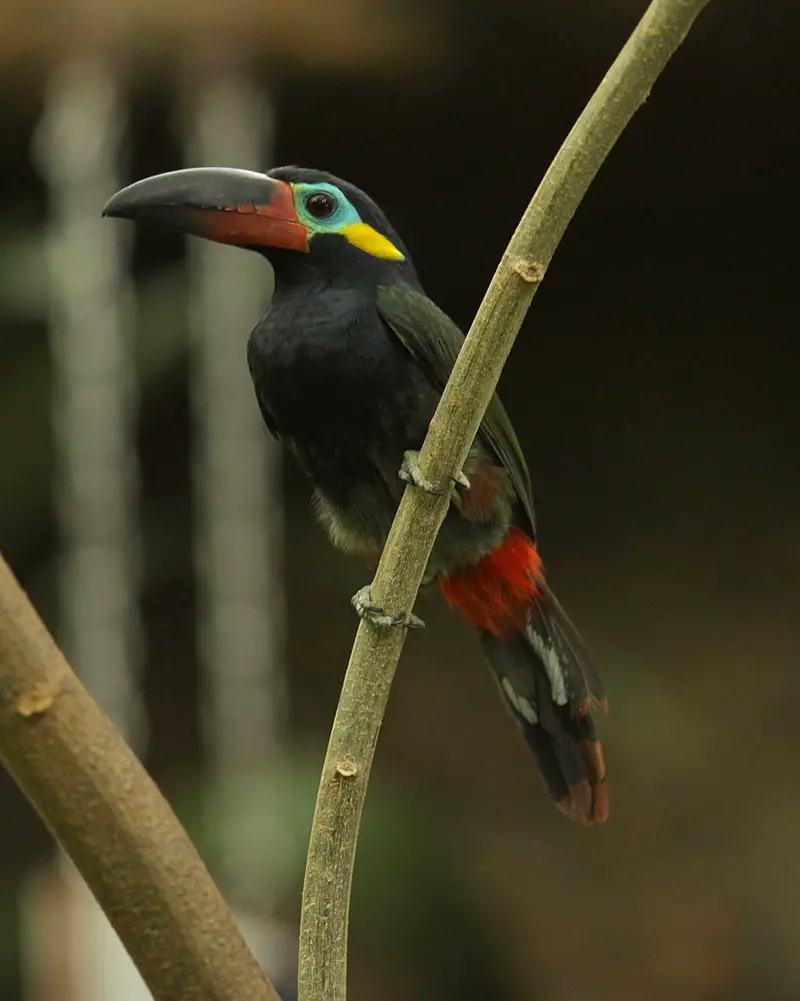
The Guianan toucanet is a colorful and unique bird that belongs to the Ramphastidae family. It can be found in Brazil, French Guiana, Guyana, Suriname and Venezuela.
This species was originally known as Ramphastos piperivorus but it has since been renamed Selenidera culik before finally achieving its current binomial name of Selenidera piperivora.
The stunning plumage of this bird consists of distinctive red markings on its forehead along with shades of black and green covering their body.
Its bill is yellowish-green with an orange stripe running down the middle which makes them quite eye catching.
They are omnivorous birds who mostly feed upon fruits like figs or berries but they also enjoy insects such as beetles or cicadas from time to time too.Scientific classification:
| Kingdom | Animalia |
| Phylum | Chordata |
| Class | Aves |
| Order | Piciformes |
| Family | Ramphastidae |
| Genus | Selenidera |
| Species | S. piperivora |
35. Guianan Warbling Antbird
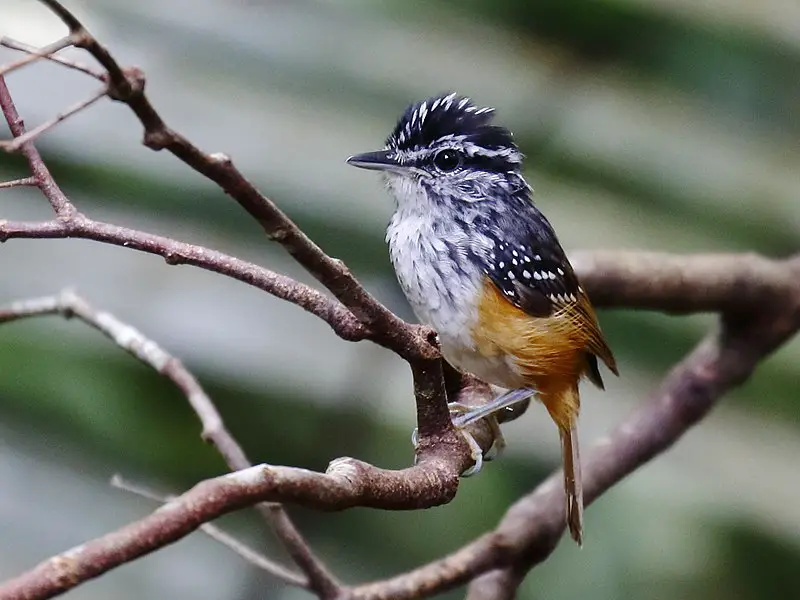
The Guianan Warbling Antbird is a species of insectivorous bird found in the humid forests of the Guiana’s, Venezuela and north-eastern Brazil.
It was first described by French polymath Georges-Louis Leclerc, Comte de Buffon, who noted its distinctive warble song which it uses to announce itself and mark territory.
The antbird has drab brown upperparts with off white underparts that contrast sharply against darker wings when in flight.
Its diet consists primarily of small insects such as ants, beetles and grasshoppers but will also feed on nectar from various flowering plants.
Its population numbers are believed to be stable at present though deforestation remains an ongoing threat for this species in addition to hunting pressures across parts of its range.Scientific classification:
| Kingdom | Animalia |
| Phylum | Chordata |
| Class | Aves |
| Order | Passeriformes |
| Family | Thamnophilidae |
| Genus | Hypocnemis |
| Species | H. cantator |
36. Large-Billed Tern
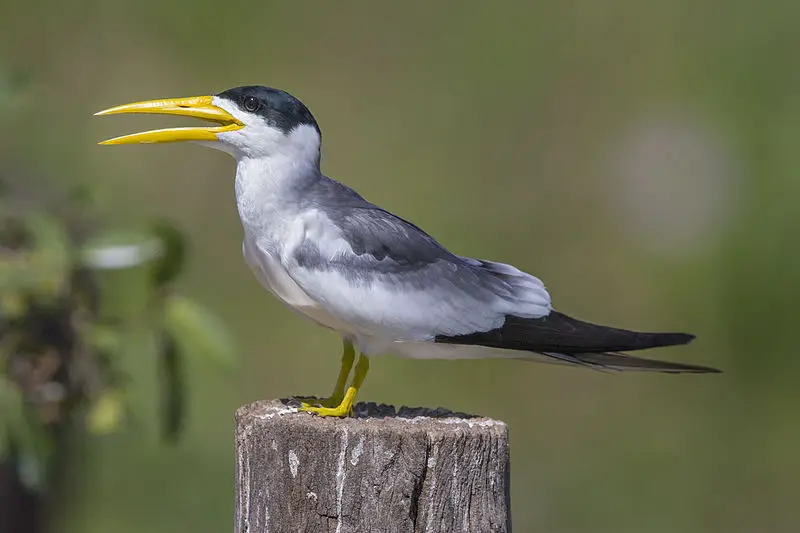
The Large-billed Tern is a species of tern found in most parts of South America. It was formally described by scientists back in 1786 and can be identified for its large bill, which it uses to feed on small fish or insects near rivers or freshwater lakes.
This bird has also been spotted as a vagrant in other countries such as Aruba, Bermuda, Cuba, Panama and the United States.
The Large-Billed Tern prefers shallow waters with plenty of vegetation around them so that they can find food easily while still providing themselves protection from larger predators.
They are quite adept at fishing using their long bills to catch prey but will also scavenge when needed.
In conclusion the Large-billed Tern is an interesting bird who plays an important role within its natural habitat.Scientific classification:
| Kingdom | Animalia |
| Phylum | Chordata |
| Class | Aves |
| Order | Charadriiformes |
| Family | Laridae |
| Genus | Phaetusa Wagler, 1832 |
| Species | P. simplex |
37. Green-Tailed Jacamar
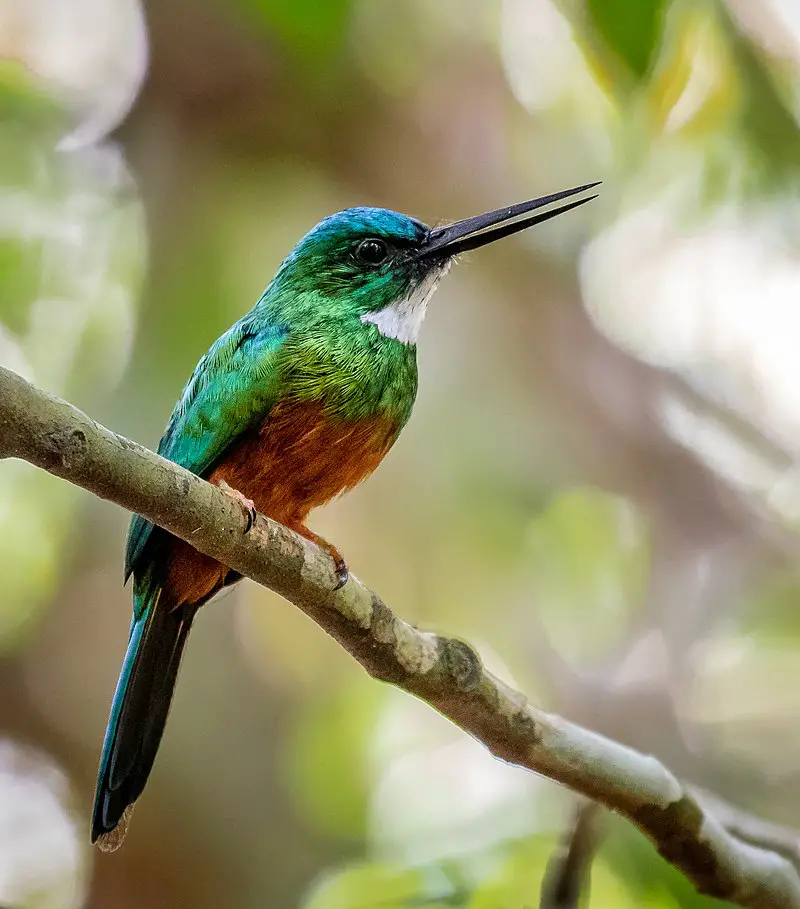
The Green-tailed Jacamar is a stunning species of bird, native to Brazil, Colombia, French Guiana, Guyana Suriname and Venezuela.
It belongs to the Galbulidae family and can be recognized by its vibrant green plumage on top with buff underparts.
Additionally it has a bright red bill that stands out against its otherwise dull colors. This monotypic species is closely related to five other jacamars; rufous-tailed, white-chinned bluish fronted and coppery chested which all form an impressive supergroup of birds known as the Picazuro group.
The Green Tailed Jacamar usually hunts high in trees for insects while they fly but may also hunt from branches or even hovering over water like kingfishers do.
They are quite secretive birds so you’ll need sharp eyesight if you’re hoping to catch sight of one.Scientific classification:
| Kingdom | Animalia |
| Phylum | Chordata |
| Class | Aves |
| Order | Piciformes |
| Family | Galbulidae |
| Genus | Galbula |
| Species | G. galbula |
38. Cocoi Heron
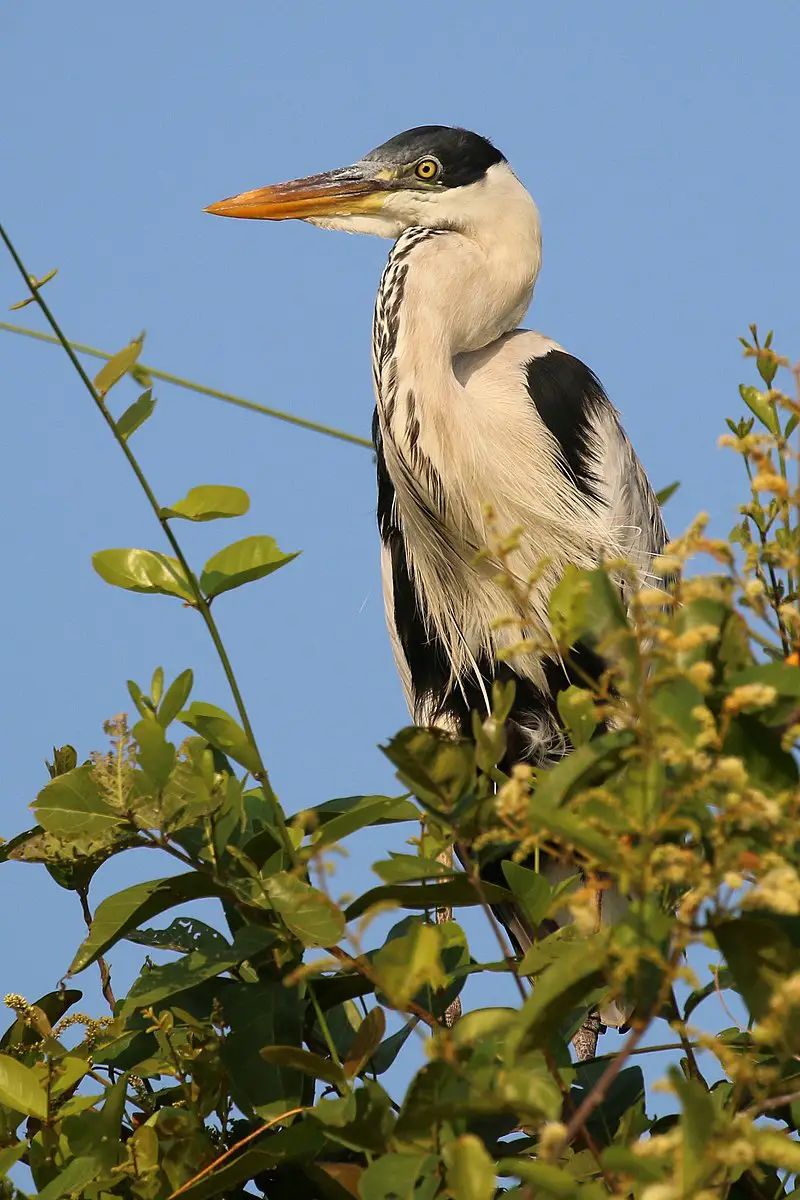
The Cocoi Heron is a majestic wading bird found in South America. It has a distinctive pale grey plumage and darker grey crest, making it easily recognizable among other herons.
This carnivore hunts for fish and crustaceans in shallow water with its long legs, giving the appearance of gracefulness even while feeding.
The origin of this species’ name remains unknown despite being first described by Carl Linnaeus back in 1766 as part of his 12th edition Systema Naturae publication.
The Cocoi Heron continues to captivate onlookers today due to its elegant beauty and remarkable hunting skills.Scientific classification:
| Kingdom | Animalia |
| Phylum | Chordata |
| Class | Aves |
| Order | Pelecaniformes |
| Family | Ardeidae |
| Genus | Ardea |
| Species | A. cocoi |
Also Featured In: Rainforest Birds You Should Know,
39. Black Nunbird
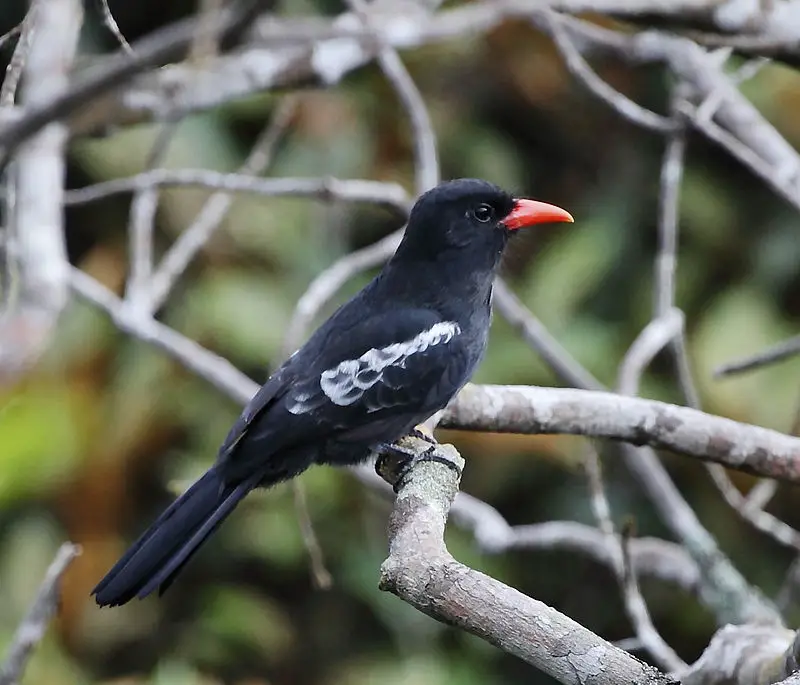
The Black Nunbird is an incredible species of near-passerine bird in the Bucconidae family. It inhabits Brazil, French Guiana, Guyana Suriname and Venezuela and was first described by Georges-Louis Leclerc in 1780.
This gorgeous creature has a distinct black plumage with white spots along its wings, back and head that make it easily recognizable among other birds.
Its diet consists mostly on fruits seeds but also small insects like beetles or caterpillars which it forages from trees during the day time.
The female will build her nest high up in tree cavities where she will lay two eggs to incubate them until they hatch after about 16 days of parental care. A beautiful sight to witness.Scientific classification:
| Kingdom | Animalia |
| Phylum | Chordata |
| Class | Aves |
| Order | Piciformes |
| Family | Bucconidae |
| Genus | Monasa |
| Species | M. atra |
40. Black-Collared Swallow
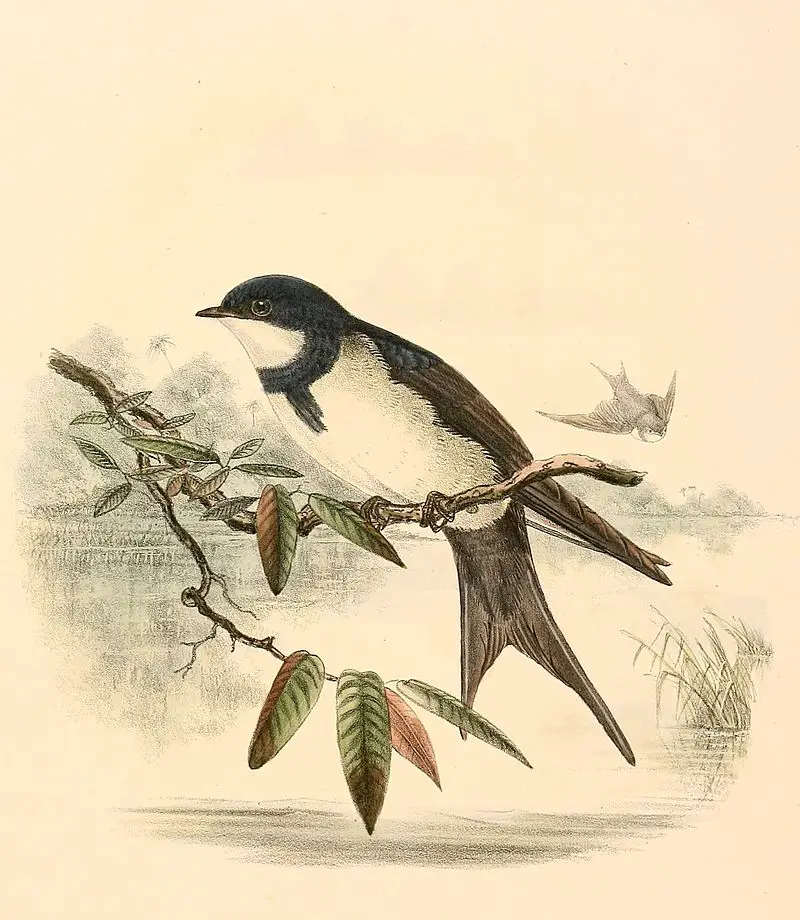
The black-collared swallow is a species of bird that can be found in South America, mainly around rivers.
It has been classified as part of the Hirundinidae family and was previously placed in the genus Atticora until a 2005 phylogenetic study moved it to the resurrected Pygochelidon genus.
This small brownish or greyish colored bird grows up to 15 cm long with its wingspan reaching 23 cm wide.
Its tail is forked, giving them an elegant appearance while flying through their natural habitat – rivers – looking after food such as insects which they scoop out from mid air during flight.
These birds are social animals often forming large flocks when searching for food or migrating together; making them quite visible on a beautiful summer day.Scientific classification:
| Kingdom | Animalia |
| Phylum | Chordata |
| Class | Aves |
| Order | Passeriformes |
| Family | Hirundinidae |
| Genus | Pygochelidon |
| Species | P. melanoleuca |
41. Finsch’s Euphonia
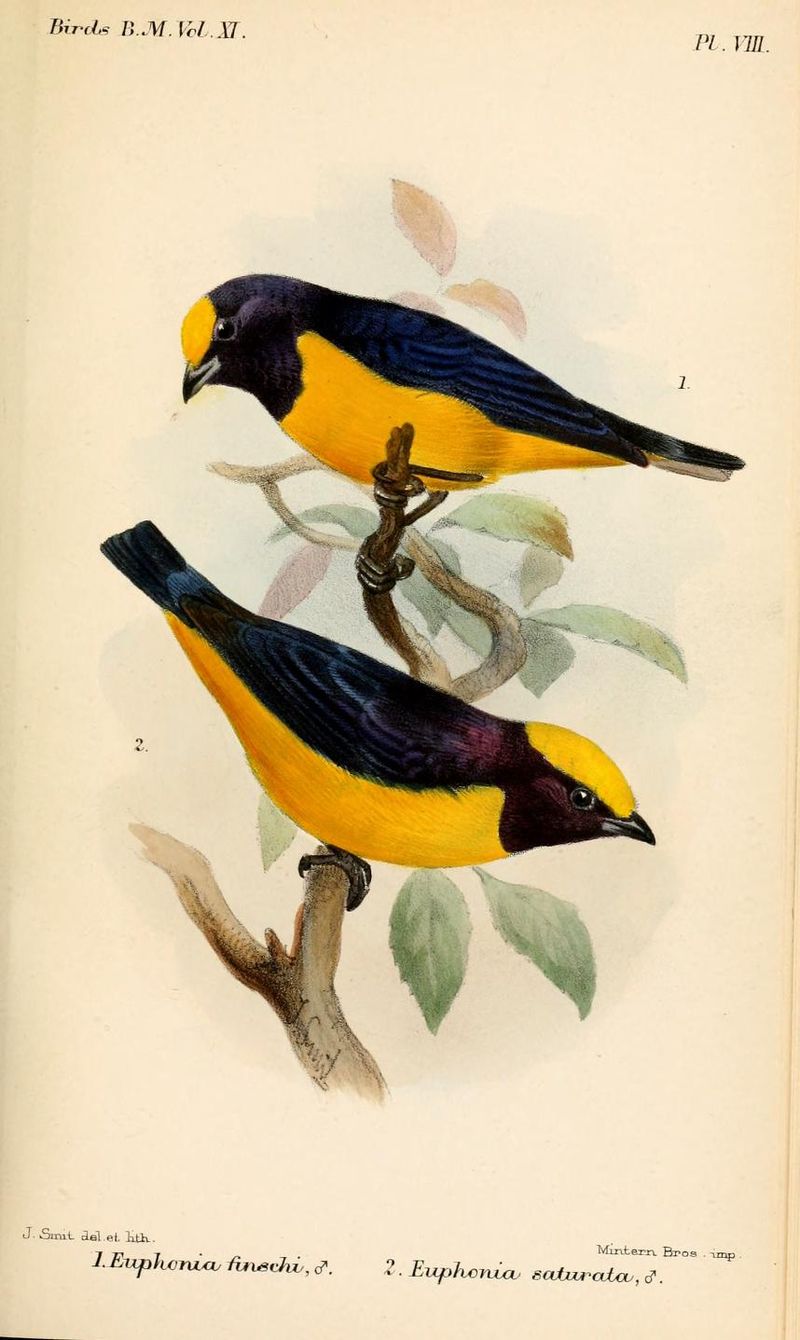
Finsch’s euphonia is a species of bird in the Fringillidae family, found in northern Brazil, French Guiana, Guyana, Suriname and eastern Venezuela.
It inhabits subtropical or tropical moist lowland forests as well as heavily degraded former forest areas.
The common name and scientific name commemorate German ethnographer Friedrich Herm Finsch.
This small songbird has an olive-green upper body with some yellow on its wings and tail feathers; it also has a black face mask that wraps around to form a “V” shape near its throat.
Its belly is pale greyish-white while its beak is dark brownish-black with white stripes running along both sides at the base of the lower mandible.
The Finsch’s Euphonia sings sweetly throughout much of their range during breeding season providing delightful music to nearby listeners.Scientific classification:
| Kingdom | Animalia |
| Phylum | Chordata |
| Class | Aves |
| Order | Passeriformes |
| Family | Fringillidae |
| Subfamily | Euphoniinae |
| Genus | Euphonia |
| Species | E. finschi |
42. Rusty-Margined Flycatcher
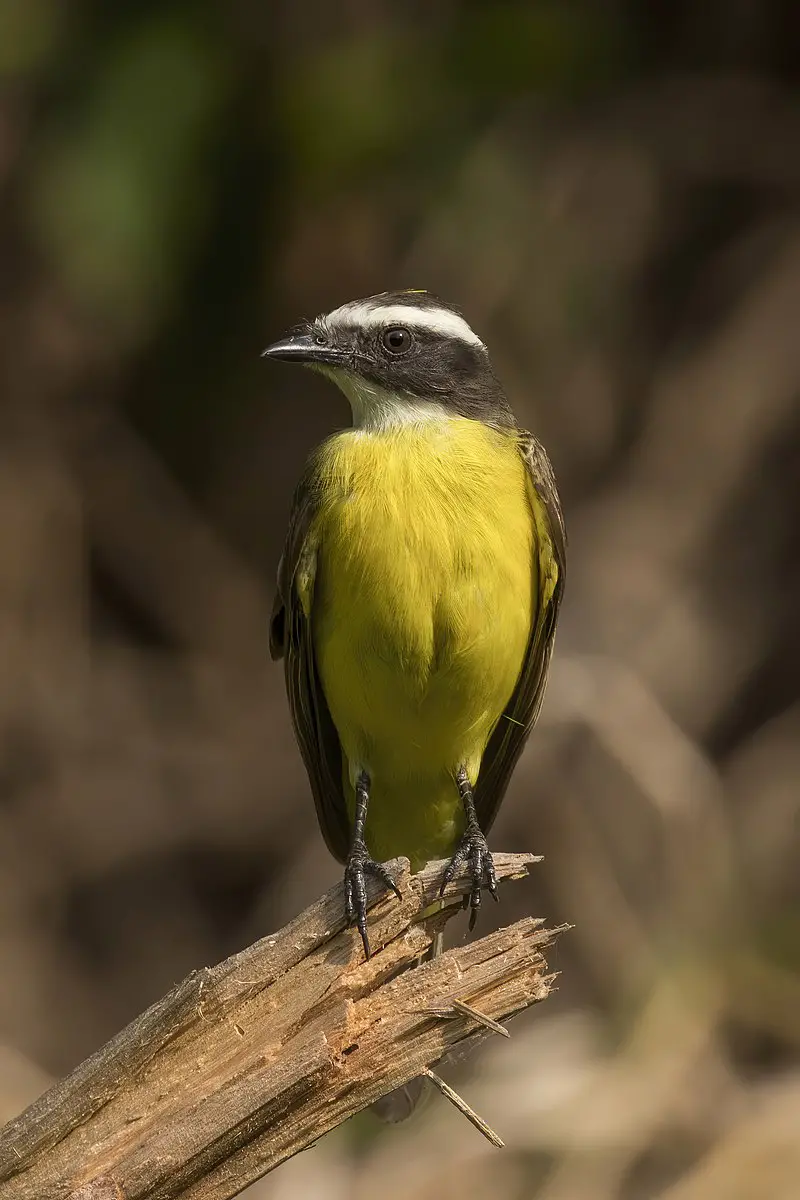
The Rusty-margined Flycatcher is a species of bird found in northern and central South America, from Bolivia to Venezuela. It also resides in eastern Panama.
This small flycatcher prefers subtropical or tropical moist lowland forests as well as heavily degraded former forest for its habitat.
Its diet consists mainly of insects that it catches midair while flying around the canopy layer; however, they will occasionally eat fruit when available too.
The rusty-margined flycatcher has an olive green back with rusty wings and tail feathers; males have black heads while females are brownish grey above their eyes and white below them instead.
This medium sized songbird is considered not threatened by IUCN but populations may be declining due to deforestation activities in some areas where these birds reside.Scientific classification:
| Kingdom | Animalia |
| Phylum | Chordata |
| Class | Aves |
| Order | Passeriformes |
| Family | Tyrannidae |
| Genus | Myiozetetes |
| Species | M. cayanensis |
43. Black-Throated Mango
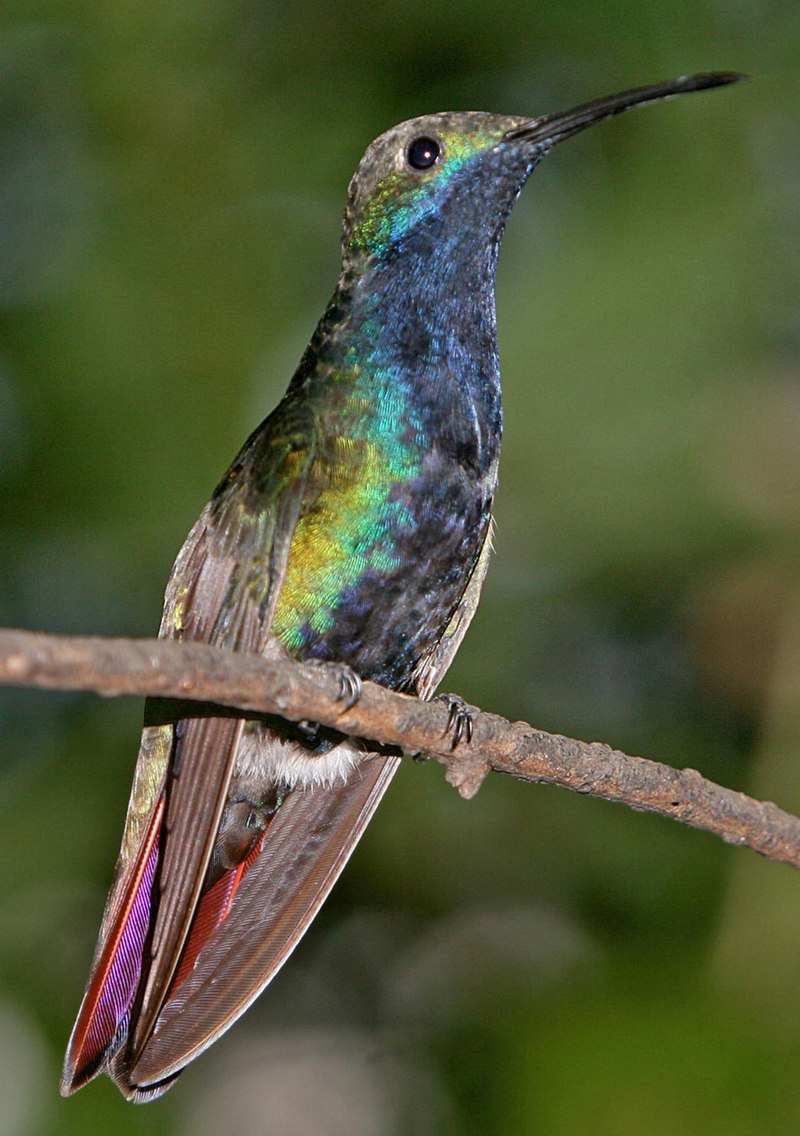
The Black-throated Mango is a beautiful species of hummingbird native to South America and Trinidad and Tobago.
It measures 10.2 cm in length, with its long black bill slightly curved at the end.
The male has bright green upperparts, while his throat and chest are matt black bordered by an iridescent golden collar on the nape area which gives it a striking appearance.
Its tail feathers have dark central ones with wine-red tips that contrast sharply with the rest of its plumage.
Females display similar features but paler than males, having greyish green upper parts without any gold or red coloration on their tails.
Despite being small in size, this bird can be easily spotted due to it’s colorful body and vibrant song.Scientific classification:
| Kingdom | Animalia |
| Phylum | Chordata |
| Class | Aves |
| Order | Apodiformes |
| Family | Trochilidae |
| Genus | Anthracothorax |
| Species | A. nigricollis |
44. White-Winged Swallow
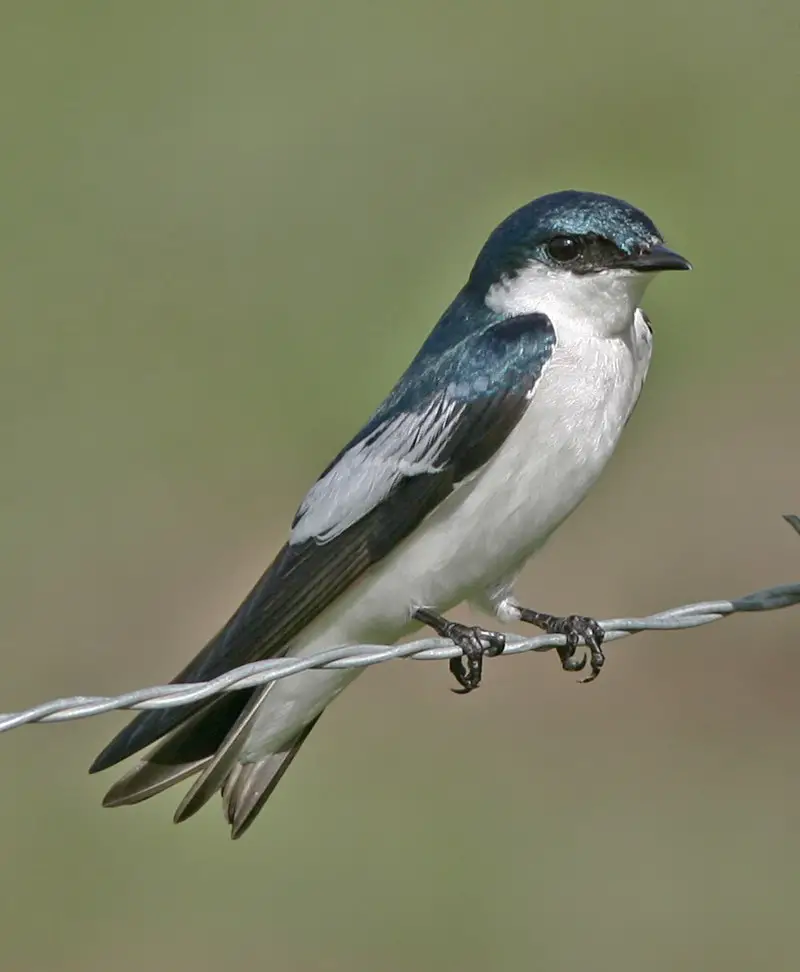
The White-winged Swallow is a small, brown bird with distinctive white patches on its wings and tail feathers. It can be found in tropical South America from Colombia to Argentina, but not west of the Andes.
These birds are mainly non-migratory and live in open habitats such as fields or grasslands.
The species was first described by Georges-Louis Leclerc in 1780 and they feed mostly on insects which they typically catch while flying low over water bodies or vegetation.
They build their nests near cliff faces where there is plenty of protection from predators such as hawks and owls.
With their beautiful plumage, these swallows make for interesting sights when spotted soaring gracefully through the air.Scientific classification:
| Kingdom | Animalia |
| Phylum | Chordata |
| Class | Aves |
| Order | Passeriformes |
| Family | Hirundinidae |
| Genus | Tachycineta |
| Species | T. albiventer |
45. Lineated Woodpecker

The Lineated Woodpecker is a large bird found in Mexico, Argentina and the Caribbean. It was first described by French zoologist Mathurin Jacques Brisson in 1760 with the name Le pic noir.
This species has black upperparts, wings and tail with white stripes running along its back and head; it also features red marks on its forehead as well as on both sides of its neck.
Its underparts are mostly greyish-white while its bill is yellowish-black and slightly hooked at the end.
These birds feed mainly on insects but can sometimes be seen foraging for fruits or tree sap too.
They nest inside cavities usually made from dead trees which they excavate themselves using their strong bills perfect for drilling into woody material easily.
All in all, these beautiful birds make an interesting addition to any backyard garden.Scientific classification:
| Kingdom | Animalia |
| Phylum | Chordata |
| Class | Aves |
| Order | Piciformes |
| Family | Picidae |
| Genus | Dryocopus |
| Species | D. lineatus |
46. Red-Capped Cardinal
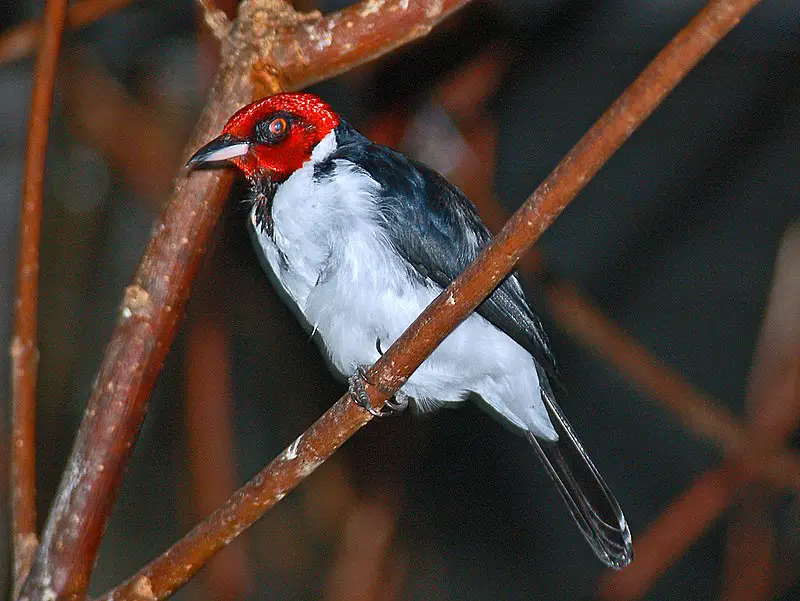
The Red-capped Cardinal is a delightful small bird found throughout South America. It has bright red plumage on its head, neck and chest which makes it stand out amongst the other birds of the same family Thraupidae.
This species was first described by French zoologist Mathurin Jacques Brisson in 1760 who named it “Le cardinal d’Amérique” or ‘Cardinalis am’.
The bird generally feeds on insects and fruits but may also consume seeds and nectar from flowers.
They form flocks for their protection when moving about looking for food sources like ants, termites or beetles among others.
During mating season males become more colourful with brighter colours than usual as they try to attract female counterparts through courtship displays involving singing duets between pairs perched high up in trees such as palm fronds or branches of shrubs near water courses.Scientific classification:
| Kingdom | Animalia |
| Phylum | Chordata |
| Class | Aves |
| Order | Passeriformes |
| Family | Thraupidae |
| Genus | Paroaria |
| Species | P. gularis |
47. Pale-Vented Pigeon
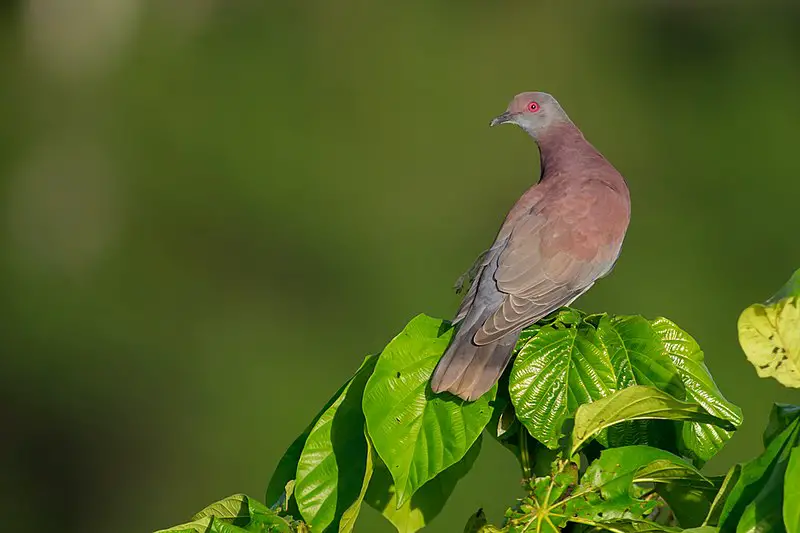
The Pale-vented pigeon is a large bird found in the tropical Americas, and belong to an evolutionary radiation of Patagioenas.
It has a grey hue all over its body, even males usually lack any iridescent colors in their plumage.
They have small heads with red eyes and short bills, while their wings are broad but pointed at the tips. Their legs are dark pink and they feed mainly on fruits from trees or shrubs.
These birds live in pairs or families throughout lightly wooded areas like pastures where they can find food easily.
However during winter months they tend to form larger flocks together for protection against predators as well as cold weather conditions.Scientific classification:
| Kingdom | Animalia |
| Phylum | Chordata |
| Class | Aves |
| Order | Columbiformes |
| Family | Columbidae |
| Genus | Patagioenas |
| Species | P. cayennensis |
Also Featured In: Birds that Live in Tabasco,
48. Rio Branco Antbird
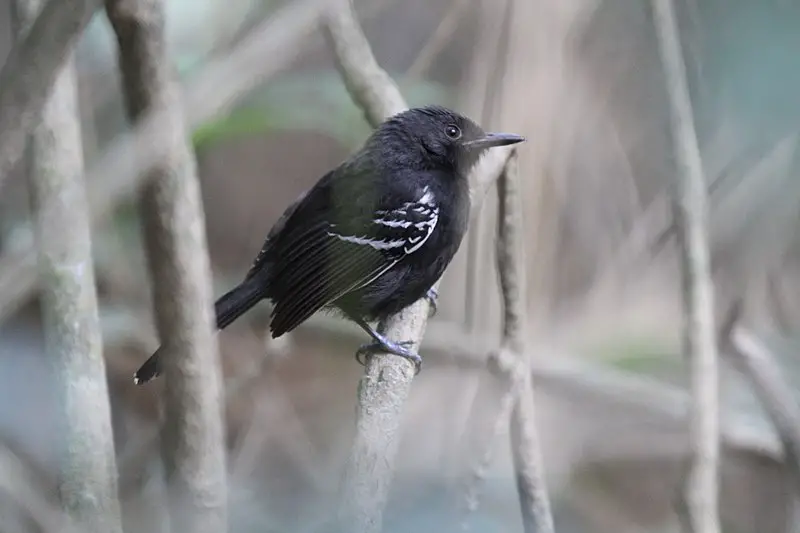
The Rio Branco antbird is a species of bird found in Brazil and Guyana. It has black-and-white plumage, with white on its throat, breast, belly and flanks contrasting sharply against the dark grey back.
Its natural habitats are subtropical or tropical moist lowland forests and shrublands.
Unfortunately this species is highly threatened due to habitat loss as more land is being used for farming activities which encroach upon their territory.
This bird feeds mainly on insects making it an important pest control agent in its native range but also contributes greatly to local biodiversity by providing food for other animals such as snakes, lizards and other birds of prey.
If conservation efforts don’t improve soon then this beautiful little creature could be lost forever from our planet’s ecosystems .Scientific classification:
| Kingdom | Animalia |
| Phylum | Chordata |
| Class | Aves |
| Order | Passeriformes |
| Family | Thamnophilidae |
| Genus | Cercomacra |
| Species | C. carbonaria |